Chamomile: A Review of Its Traditional Uses, Chemical Constituents, Pharmacological Activities and Quality Control Studies
Abstract
1. Introduction
2. Methodology
2.1. Botanical Characteristics and Geographical Distribution
2.2. Traditional Uses
2.3. Chemical Constituents
2.3.1. Organic Acids
2.3.2. Flavonoids
2.3.3. Coumarins
2.3.4. Volatile Oil
2.3.5. Monoterpenes
2.3.6. Sesquiterpenes
2.3.7. Diterpenes and Triterpenes
2.3.8. Other Phytochemicals
3. Pharmacological Activities
3.1. Anticancer Activity
3.2. Anti-Infective Activity
3.3. Anti-Inflammatory Activity
3.4. Antithrombotic Activity
3.5. Antioxidant Activity
3.6. Hypoglycaemic Activity
3.7. Antihypertensive Activity
3.8. Hypolipidaemic Activity
3.9. Antiallergy Activity
3.10. Antidepressant Activity
3.11. Organoprotective Effect
3.11.1. Hepatoprotective and Pulmoprotective Effect
3.11.2. Nephroprotective Effect
3.11.3. Gastroprotective Effect
3.12. Genitoprotective Effect
3.13. Neuroprotective Effect
3.14. Analgesic Activity
3.15. Antidiarrheal and Antispasmodic Activity
3.16. Cosmetic Activity
3.17. Other Activities
4. Other Aspects
4.1. Adverse Reactions
4.2. Toxicity Studies
4.3. Clinical Preparation
4.4. Quality Control Studies
5. Discussion and Conclusions
Author Contributions
Funding
Acknowledgments
Conflicts of Interest
Abbreviations
| Abbreviations | Full name |
| TCM | Traditional Chinese medicine |
| MC | Matricaria chamomilia L. |
| CN | Chamaemelum nobile (L.) All. |
| 4-MUO | 4-Methylumbelliferone oleate |
| LPS | lipopolysaccharide |
| BV2 | a microglia |
| GSK-3β/Nrf2 | Glycogen Synthase Kinase 3β/Nuclear factor E2 related factor 2 |
| QAMS | quantitative analysis for multi-components by single marker |
| GC-MS | gas chromatography-mass spectrometry |
| APAP | acetaminophen |
| MyoD | myogenic differentiation |
| GABA | γ-aminobutyric acid |
| c-Met | central mucoepidermoid tumor |
| Caco-2 | a colon cancer cell |
| VEGFR2 | vascular epidemal growth factor receptor-2 |
| Hep G2 | a liver cancer cell |
| HL-60 | a leukaemia cell |
| HeLa | a cervical cancer cell |
| Wnt5A | wingless integration-5A |
| Tcf4 | transfer cell factor 4 |
| APC | antigen presenting cell |
| MCF-7 | michigan cancer foundation-7 |
| MDA-MB-468 | a triple-negative breast cancer cell line |
| MRC-5 | medical research council cell strain 5 |
| MCh-AMP1 | Mean corpsular hemoglobin—ampicillin 1 |
| ROS | reactive oxygen species |
| MIC90 | minimun inhibitory concentration 90 |
| NF-κB | nuclear factor kappa beta |
| TNF-α | tumor necrosis factor alpha |
| IL-1β | interleukin-1β |
| CVD | cardiovascular disease |
| ADP | adenosine diphosphate |
| IC50 | half-maximal inhibitory concentrations |
| ACE | angiotensin-converting enzyme |
| DPPH | the 1,1-diphenyl-2-picrylhydrazyl |
| SOD | superoxide dismutase |
| GSH-PX | glutathione peroxidase |
| MDA | malondialdehyde |
| FBG | fibrinogen |
| GSP | glycated serum protein |
| STZ | streptozotocin |
| SBP | systolic blood pressure |
| DBP | diastolic blood pressure |
| L-NNA | N-omega-nitro-L-arginine |
| Ang Ⅱ | angiotension Ⅱ |
| HLP | hyperlipidaemia |
| TC | serum total cholesterol |
| TG | triglyceride |
| LDL-C | low-density lipoprotein cholesterol |
| HDL-C | high-density lipoprotein cholesterol |
| β-Hex | β-hexosaminidase |
| RBL-2H3 | rat basophil leukemia |
| iTRAQ | isobaric tag for relative and absolute quantitation |
| PCR | polymerase chain reaction |
| DMH | 1,2-Dimethyl hydrazine |
| TAC | total antioxidant capacity |
| tTG | tissue transglutaminase |
| PQ | paraquat |
| AMPK/GSK-3β | adenosine monophosphate-activated protein kinase/glycogen synthase kinase 3β |
| CPT1A | carnitine palmitoyl transferase 1A |
| Nrf2 | nuclear factor erythroid 2-related factor 2 |
| LPO | lipid peroxidation |
| GPx | glutathione peroxidase |
| TAP | transporter associated with antigen processing |
| PCOS | polycystic ovary syndrome |
| LH | luteinizing hormone |
| BDNF | brain-derived neurotrophic factor |
| HT22 | a hippocampal cell |
| CPZ | chlorpromazine |
| VAS | visual analogue scale |
| BPC | breast pain scale |
| MuRF1 | muscle ring finger-1 |
| TFAM | mitochondrial transcription factor A |
| EOS | eosinophils |
| TGF-β1 | transforming growth factor β1 |
| CFs | cardiac fibroblasts |
| ECM | extracellular matrix |
| miR-155-5p | microRNA-155-5p |
| HPLC | High Performance Liquid Chromatography |
| UV | Utlraviolet |
References
- Tian, L.J.; Huang, T.K. Research on the development history of traditional Chinese medicine. Chin. Arch. Tradit. Chin. Med. 2007, 4, 753–755. [Google Scholar] [CrossRef]
- Zhou, P. Traditional Chinese medicine. Comb. Chem. High Throughput Screen 2010, 13, 836. [Google Scholar] [CrossRef] [PubMed]
- Ubessi, C.; Tedesco, S.B.; de Bona da Silva, C.; Baldoni, M.; Krysczun, D.K.; Heinzmann, B.M.; Rosa, I.A.; Mori, N.C. Antiproliferative potential and phenolic compounds of infusions and essential oil of chamomile cultivated with homeopathy. J. Ethnopharmacol. 2019, 239, 111907. [Google Scholar] [CrossRef]
- Wan, W.T.; Song, Y.J.; Xu, L.J.; Xiao, P.G.; Miao, J.H. Research Review and Application Prospect Analysis of Matricaria. Mod. Chin. Med. 2019, 21, 260–265. [Google Scholar] [CrossRef]
- Singh, O.; Khanam, Z.; Misra, N.; Srivastava, M.K. Chamomile (Matricaria chamomilla L.): An overview. Pharm. Rev. 2011, 5, 82–95. [Google Scholar] [CrossRef] [PubMed]
- Zhao, D.S.; Han, S.L.; Yi, Y.J.; Qiu, L.; Ren, L.J.; Li, X.X. Standard operating procedure for standardized planting of local medicinal herb German chamomile. J. Anhui Agric. Sci. 2015, 43, 70+85. [Google Scholar] [CrossRef]
- Zhao, Y.F. Study on Chemical Composition and Quality Standard of Uyghur Chamomile. Master’s Thesis, China Academy of Chinese Medical Sciences, Beijing, China, 2018. [Google Scholar]
- Fen, M.Y. Deciphering Chamomile Essential Oil. Chin. Cosmet. 2021, 12, 120–122. [Google Scholar]
- Petronilho, S.; Maraschin, M.; Delgadillo, I.; Coimbra, M.A.; Rocha, S.M. Sesquiterpenic composition of the inflorescences of Brazilian chamomile (Matricaria recutita L.): Impact of the agricultural practices. Ind. Crops Prod. 2011, 34, 1482–1490. [Google Scholar] [CrossRef]
- Liu, X.M.; Meng, X.X.; Zhang, W.W.; Liao, Y.L.; Chang, J.; Xu, F. Tissue Culture Technique of Chamomile. North. Hortic. 2018, 2, 72–76. [Google Scholar] [CrossRef]
- Ren, L.J.; Yuan, J.; Han, S.L.; Li, X.X.; Yao, J. Digital Microscopic Identification of Two Kinds of Chamomile Medicinal Materials in Xinjiang and Preliminary Study on Pharmacology. J. Xinjiang Med. Univ. 2016, 39, 724–726. [Google Scholar]
- Wang, Y.; Zhou, C.; Wu, Q.; Wang, Y.H. An Analysis of the Medicines for Treating Heart Diseases in Shennong’s Herbal Classic. J. Tradit. Chin. Med. Lit. 2021, 39, 26–30. [Google Scholar] [CrossRef]
- Srivastava, J.K.; Shankar, E.; Gupta, S. Chamomile: A herbal medicine of the past with bright future. Mol. Med. Rep. 2010, 3, 895–901. [Google Scholar] [CrossRef] [PubMed]
- Mazokopakis, E.E.; Vrentzos, G.E.; Papadakis, J.A.; Babalis, D.E.; Ganotakis, E.S. Wild chamomile (Matricaria recutita L.) mouthwashes in methotrexate-induced oral mucositis. Phytomedicine. 2005, 12, 25–27. [Google Scholar] [CrossRef] [PubMed]
- Xiao, W.H.; Yang, C.H.; Xu, Q.L.; Zhu, B.H.; Li, D.Y.; Xiao, X. Development of Compound Artemisia annua Low Alcohol Mosquito Repellent Liquid. Jiangxi Chem. Ind. 2017, 2, 91–92. [Google Scholar] [CrossRef]
- Wang, Z.Y.; Jiang, M.Y. Observation on the curative effect of traditional Chinese medicine chamomile Jinshui in the treatment of heat prickly heat in children. Clin. J. Chin. Med. 2016, 8, 117+119. [Google Scholar] [CrossRef]
- Wang, S.D.; Jin, Y.L.; Li, D.P. Clinical application of traditional Chinese medicine bathing agent. Res. Tradit. Chin. Med. 2000, 2, 60–61. [Google Scholar]
- McKay, D.L.; Blumberg, J.B. A review of the bioactivity and potential health benefits of chamomile tea (Matricaria recutita L.). Phytother. Res. 2006, 20, 519–530. [Google Scholar] [CrossRef]
- Huang, D.J. Development and Utilization of Herb Plants. North. Hortic. 2006, 3, 113–114. [Google Scholar] [CrossRef]
- Orav, A.; Raal, A.; Arak, E. Content and composition of the essential oil of Chamomilla recutita (L.) Rauschert from some European countries. Nat. Prod. Res. 2010, 24, 48–55. [Google Scholar] [CrossRef]
- Lv, Y.; Guo, W.F. Originating from Western “tea culture”—Vanilla and vanilla tea. China Tea Process. 1999, 4, 34–38. [Google Scholar] [CrossRef]
- Hu, Y.Z. Honey paste tea drink. J. Bee 2020, 40, 38. [Google Scholar]
- Gould, L.; Reddy, C.V.; Gomprecht, R.F. Cardiac effects of chamomile tea. J. Clin. Pharmacol. 1973, 13, 475–479. [Google Scholar] [CrossRef] [PubMed]
- Guo, X.Y. Analysis of volatile components of chamomile essential oil and its application in beverages. Chin. Agric. Sci. Bull. 2021, 37, 138–145. [Google Scholar] [CrossRef]
- Guzelmeric, E.; Ristivojević, P.; Vovk, I.; Milojković-Opsenica, D.; Yesilada, E. Quality assessment of marketed chamomile tea products by a validated HPTLC method combined with multivariate analysis. J. Pharm. Biomed. Anal. 2017, 132, 35–45. [Google Scholar] [CrossRef] [PubMed]
- Tang, H.; Zhang, T.J.; Wang, S.; Qiao, A.N.; Cao, L.; Cui, W.Y. Preparation of traditional Chinese medicinal incense for preventing and treating insomnia. Sci. Technol. Ecnony Mark. 2014, 2, 90–91. [Google Scholar] [CrossRef]
- Zhang, Q.H. Pharmacological Experiment Study on Qingdan Capsule of Traditional Chinese Medicine. J. Guangdong Pharm. Univ. 2001, 3, 181–183. [Google Scholar] [CrossRef]
- Xu, R.T. The effect of crude drug extract bath in the treatment of rheumatoid arthritis. World Phytomedicines 1995, 5, 15. [Google Scholar]
- Ma, D.W. A Traditional Chinese Medicine Composition for Sunscreen Cosmetics Containing Marigold. CN105796448A, 8 June 2016. [Google Scholar]
- Wang, Z.Z. Application of natural ingredients in cosmetics. Proceedings of The 6th Southeast Asia Regional Medical Aesthetics Conference, Dalian, China, 8 August 2001; pp. 161–162. [Google Scholar]
- Lu, H.M. A Kind of Compound Plant Extract Repair Liquid and Preparation Method Thereof. CN112754979A, 3 February 2021. [Google Scholar]
- Chen, G.R.; Xin, Y.H. Antiviral Traditional Chinese Medicine Composition and Its Application. CN113797266A, 11 June 2020. [Google Scholar]
- Zhao, Y.F.; Zhang, D.; Yang, L.X.; Wang, K.; Ma, Y.; Yang, L. Determination of Volatile Components in Different Parts of Chamomile by HS-SPME-GC-MS. Chin. J. Exp. Tradit. Med. Formulae 2018, 24, 69–73. [Google Scholar] [CrossRef]
- Maimedy, M.; Wang, Y.; Zhao, S.J.; Lan, W. Analysis of total flavonoids of chamomile and its inhibitory effect on pancreatic lipase. Chem. Bioeng. 2021, 38, 62–67. [Google Scholar] [CrossRef]
- Zhao, Y.F.; Zhang, D.; Liang, C.X.; Yang, L.X.; Sun, P.; Ma, Y.; Wang, K.; Chang, X.Q.; Yang, L. Study on chemical constituents of Uyghur chamomile I. J. Chin. Pharm. Sci. 2018, 27, 324–331. [Google Scholar]
- Xu, Y.B.; Tang, H.; Zhu, S.Y.; Zhe, W.; Wang, K.; Mao, D.s.; Fu, L.; Chen, R.K. Analysis of volatile components in chamomile oil from different origins by gas chromatography time-of-flight mass spectrometry. Sci. Technol. Food Ind. 2015, 36, 69–74. [Google Scholar] [CrossRef]
- Li, B.; Zhou, W. Analysis of Chamomile Essential Oil by MassWorks~(TM) and Gas Chromatography-Mass Spectrometry. J. Chin. Mass Spectrom. Soc. 2011, 32, 241–245. [Google Scholar]
- Wang, G.L. Study on Active Ingredients of Chamomile for Whitening and Moisturizing. Master’s Thesis, Jiangnan University, Wuxi, China, 2016. [Google Scholar]
- Tvrzicka, E.; Kremmyda, L.S.; Stankova, B.; Zak, A. Fatty acids as biocompounds: Their role in human metabolism, health and disease—A review. Part 1: Classification, dietary sources and biological functions. Biomed. Pap. Med. Fac. Univ. Palacky Olomouc. Czech Repub. 2011, 155, 117–130. [Google Scholar] [CrossRef] [PubMed]
- Yang, Y.S.; Pan, L.S. Isolation and Structure Determination of Flavonoids in Chamomile. Appl. Chem. Ind. 2008, 6, 697–698. [Google Scholar] [CrossRef]
- Chen, P.; Huo, X.; Liu, W.; Li, K.; Sun, Z.; Tian, J. Apigenin exhibits anti-inflammatory effects in LPS-stimulated BV2 microglia through activating GSK3β/Nrf2 signaling pathway. Immunopharmacol. Immunotoxicol. 2020, 42, 9–16. [Google Scholar] [CrossRef]
- Asadi, Z.; Ghazanfari, T.; Hatami, H. Anti-inflammatory Effects of Matricaria chamomilla Extracts on BALB/c Mice Macrophages and Lymphocytes. Iran J. Allergy Asthma Immunol. 2020, 19, 63–73. [Google Scholar] [CrossRef] [PubMed]
- Petruľová-Poracká, V.; Repčák, M.; Vilková, M.; Imrich, J. Coumarins of Matricaria chamomilla L.: Aglycones and glycosides. Food Chem. 2013, 141, 54–59. [Google Scholar] [CrossRef]
- Li, J.G.; Han, S.L.; Zhao, D.S.; Zhang, H.B.; Geng, J.; Li, X.X. Determination of five chemical constituents in two kinds of chamomile in Xinjiang by one test and multiple evaluation method. Her. Med. 2014, 33, 1491–1495. [Google Scholar] [CrossRef]
- Setzer, W.N. Essential oils and anxiolytic aromatherapy. Nat. Prod. Commun. 2009, 4, 1305–1316. [Google Scholar] [CrossRef]
- Zhang, Q.S.; Wang, X.P.; Wu, L.L.; Xiang, Y. Protective effect of bisabolol on acetaminophen-induced acute liver injury in mice. J. Hubei Minzu Univ. 2018, 35, 5–7. [Google Scholar] [CrossRef]
- Chen, L.; He, X.M.; Meng, L.; Ma, X.L. Comparison of Determination of Monosaccharide Components in Chamomile Polysaccharides by High Performance Liquid Chromatography and High Performance Capillary Electrophoresis. Food Drug 2019, 21, 347–351. [Google Scholar] [CrossRef]
- Jing, Y.X.; Guo, Y.T.; Lan, W. Determination of 6 kinds of trace elements in chamomile. J. Xinjiang Med. Univ. 2013, 36, 1282–1283. [Google Scholar] [CrossRef]
- Xin, L.D.; Li, Q.; Wang, J.L.; Lao, F.; Tian, S.G. Determination of Arsenic in Chamomile by Microwave Digestion-Atomic Fluorescence Spectrometry. J. Xinjiang Med. Univ. 2014, 37, 860–861. [Google Scholar] [CrossRef]
- Yan, H.B.; Xu, R.X. Effects of α-bisabolol on migration and invasion of glioblastoma cells. Acad. J. Pla Postgrad. Med. Sch. 2018, 39, 699–706. [Google Scholar] [CrossRef]
- Shaaban, M.; El-Hagrassi, A.M.; Osman, A.F.; Soltan, M.M. Bioactive compounds from Matricaria chamomilla: Structure identification, in vitro antiproliferative, antimigratory, antiangiogenic, and antiadenoviral activities. Z Nat. C J. Biosci. 2021, 77, 85–94. [Google Scholar] [CrossRef]
- Hu, J.S.; Chen, J.P.; Chen, L.; Wu, X.F.; Wang, K.Q.; Liu, Z.H. Screening of celery flavonoids for antihypertensive, lipid-lowering and antitumor pharmacological activities. Hunan Agric. Sci. 2014, 11, 9–12. [Google Scholar] [CrossRef]
- Srivastava, J.K.; Gupta, S. Antiproliferative and apoptotic effects of chamomile extract in various human cancer cells. J Agric Food Chem. 2007, 55, 9470–9478. [Google Scholar] [CrossRef]
- Lan, W.; Guo, Y.T.; Chen, Y.; Duan, M.H.; Geng, Z.; Ni, J. Study on the effect of Uygur chamomile on inhibiting the proliferation of cervical cancer Hela cells in vitro. Yunnan J. Tradit. Chin. Med. Mater. Med. 2016, 37, 54–55. [Google Scholar] [CrossRef]
- El Joumaa, M.M.; Taleb, R.I.; Rizk, S.; Borjac, J.M. Protective effect of Matricaria chamomilla extract against 1,2-dimethylhydrazine-induced colorectal cancer in mice. J. Complement Integr. Med. 2020, 17, 20190143. [Google Scholar] [CrossRef]
- Nikseresht, M.; Kamali, A.M.; Rahimi, H.R.; Delaviz, H.; Toori, M.A.; Kashani, I.R.; Mahmoudi, R. The Hydroalcoholic Extract of Matricaria chamomilla Suppresses Migration and Invasion of Human Breast Cancer MDA-MB-468 and MCF-7 Cell Lines. Pharmacogn. Res. 2017, 9, 87–95. [Google Scholar] [CrossRef]
- Park, E.H.; Bae, W.Y.; Eom, S.J.; Kim, K.T.; Paik, H.D. Improved antioxidative and cytotoxic activities of chamomile (Matricaria chamomilla) florets fermented by Lactobacillus plantarum KCCM 11613P. J Zhejiang Univ. Sci. B 2017, 18, 152–160. [Google Scholar] [CrossRef] [PubMed]
- Felšöciová, S.; Kačániová, M.; Horská, E.; Vukovič, N.; Hleba, L.; Petrová, J.; Rovná, K.; Stričík, M.; Hajduová, Z. Antifungal activity of essential oils against selected terverticillate penicillia. Ann. Agric. Environ. Med. 2015, 22, 38–42. [Google Scholar] [CrossRef] [PubMed]
- Abd El-Moneim, M.R.; Fatma, S.A.; Turky, A.F. Control of Tetranychus urticae Koch by extracts of three essential oils of chamomile, marjoram and Eucalyptus. Asian Pac. J. Trop Biomed. 2012, 2, 24–30. [Google Scholar] [CrossRef] [PubMed]
- Seyedjavadi, S.S.; Khani, S.; Eslamifar, A.; Ajdary, S.; Goudarzi, M.; Halabian, R.; Akbari, R.; Zare-Zardini, H.; Imani Fooladi, A.A.; Amani, J.; et al. The Antifungal Peptide MCh-AMP1 Derived From Matricaria chamomilla Inhibits Candida albicans Growth via Inducing ROS Generation and Altering Fungal Cell Membrane Permeability. Front. Microbiol. 2019, 10, 3150. [Google Scholar] [CrossRef] [PubMed]
- Shikov, A.N.; Pozharitskaya, O.N.; Makarov, V.G.; Kvetnaya, A.S. Antibacterial activity of Chamomilla recutita oil extract against Helicobacter pylori. Phytother. Res. 2008, 22, 252–253. [Google Scholar] [CrossRef] [PubMed]
- He, H.; Jiang, X.J.; Wang, X.T.; Wang, S.J.; Xia, X.Y. Clinical effect of white gold medallion compositae essence product on various oral discomfort and mucosal diseases. Electron. J. Gen. Stomatol. 2018, 5, 77–80. [Google Scholar] [CrossRef]
- Bulgari, M.; Sangiovanni, E.; Colombo, E.; Maschi, O.; Caruso, D.; Bosisio, E.; Dell’Agli, M. Inhibition of neutrophil elastase and metalloprotease-9 of human adenocarcinoma gastric cells by chamomile (Matricaria recutita L.) infusion. Phytother. Res. 2012, 26, 1817–1822. [Google Scholar] [CrossRef]
- Yuan, Y.; Long, Z.J.; Yang, J.J.; Yuan, C.H. Study on the anti-inflammatory effect of Chamomile Volatile Oil. Pharm. Biotechnol. 2011, 18, 52–55. [Google Scholar] [CrossRef]
- Wang, Y.; Ma, H.M.; Lan, W.; Zhao, F.C. Effects of chamomile on blood sugar and antithrombotic effect of type 1 diabetes model mice. Chem. Bioeng. 2020, 37, 28–32. [Google Scholar] [CrossRef]
- Memariani, Z.; Moeini, R.; Hamedi, S.S.; Gorji, N.; Mozaffarpur, S.A. Medicinal plants with antithrombotic property in Persian medicine: A mechanistic review. J. Thromb. Thrombolysis 2018, 45, 158–179. [Google Scholar] [CrossRef]
- Bijak, M.; Saluk, J.; Tsirigotis-Maniecka, M.; Komorowska, H.; Wachowicz, B.; Zaczyńska, E.; Czarny, A.; Czechowski, F.; Nowak, P.; Pawlaczyk, I. The influence of conjugates isolated from Matricaria chamomilla L. on platelets activity and cytotoxicity. Int. J. Biol. Macromol. 2013, 61, 218–229. [Google Scholar] [CrossRef] [PubMed]
- Bas, Z.; Turkoglu, V.; Goz, Y. Investigation of inhibition effect of butanol and water extracts of Matricaria chamomilla L. on angiotensin-converting enzyme purified from human plasma. Biotechnol. Appl. Biochem. 2021, 69, 273–280. [Google Scholar] [CrossRef] [PubMed]
- Yuan, Y.; Wang, D.; Sun, B.X.; Zhang, H.G.; Zhang, Y.F. Study on the application of chamomile volatile oil. J. Anhui Agric. Sci. 2020, 48, 211–213. [Google Scholar] [CrossRef]
- Lu, J.A.; Xie, D.X.; He, L.Y.; Wang, Y.; Zheng, Z.Y. Isolation, purification, properties, structure and antioxidant activity of chamomile polysaccharides. Food Ferment. Ind. 2021, 47, 72–78. [Google Scholar] [CrossRef]
- Lu, J.; Chang, Q.Q.; Xie, D.X.; Tan, L.; Gao, J.X. Optimization of ultrasonic extraction process of chamomile polysaccharide and study on its free radical scavenging ability. China Food Addit. 2018, 3, 124–130. [Google Scholar] [CrossRef]
- Ye, Q.; Wang, Y.; Li, S.C.; Mei, Y. Study on chemical constituents and DPPH free radical scavenging activity of Uygur chamomile. Natural Product Research and Development 2019, 31, 1907–1911. [Google Scholar] [CrossRef]
- Chu, B.Q.; Fang, R.S.; Li, L.; Xiao, G.N.; Yuan, H.N.; Gong, J.Y. Antioxidant activity and active components analysis of each extract phase of chamomile. Sci. Technol. Food Ind. 2019, 40, 1–6. [Google Scholar] [CrossRef]
- Al-Dabbagh, B.; Elhaty, I.A.; Elhaw, M.; Murali, C.; Al Mansoori, A.; Awad, B.; Amin, A. Antioxidant and anticancer activities of chamomile (Matricaria recutita L.). BMC Res. Notes 2019, 12, 3. [Google Scholar] [CrossRef]
- Ma, H.M.; Wang, Y.; Lan, W. Effects of chamomile extract on blood glucose and antioxidant activity in type 2 diabetic mice. Shanghai J. Tradit. Chin. Med. 2020, 54, 77–82. [Google Scholar] [CrossRef]
- Chen, S.C.; Chen, J.; Li, T.J.; Zheng, L.Y.; Yao, Y.; Wang, C.X. Effects of chamomile extract on endometrial tissue, insulin resistance, leptin and blood lipid levels in rats with polycystic ovary syndrome. Pract. Pharm. Clin. Remedies 2021, 24, 400–404. [Google Scholar] [CrossRef]
- Lan, W.; Guo, Y.T.; Chen, Y.; Duan, M.H.; Geng, Z.; Ni, J. Effects of Uygur chamomile on blood glucose and glucose tolerance in normal mice. J. Yunnan Univ. Tradit. Chin. Med. 2016, 39, 10–12. [Google Scholar] [CrossRef]
- Yang, Y.L.; Wang, Y.; Ma, H.M.; Lan, W. Hypoglycemic effect of German chamomile total flavonoids on diabetic mice. J. Food Saf. Qual. 2020, 11, 1524–1528. [Google Scholar] [CrossRef]
- Cemek, M.; Kağa, S.; Simşek, N.; Büyükokuroğlu, M.E.; Konuk, M. Antihyperglycemic and antioxidative potential of Matricaria chamomilla L. in streptozotocin-induced diabetic rats. J. Nat. Med. 2008, 62, 284–293. [Google Scholar] [CrossRef] [PubMed]
- Luo, Y.N.; Qin, X.L.; Huang, Z.Y.; Yang, J.Y.; Akorem, A.; Luo, J.J. Protective effect of chamomile extract on kidney in hypertensive rats. Biotechnology. 2022, 32, 350–354. [Google Scholar] [CrossRef]
- Awaad, A.A.; El-Meligy, R.M.; Zain, G.M.; Safhi, A.A.; Al Qurain, N.A.; Almoqren, S.S.; Zain, Y.M.; Sesh Adri, V.D.; Al-Saikhan, F.I. Experimental and clinical antihypertensive activity of Matricaria chamomilla extracts and their angiotensin-converting enzyme inhibitory activity. Phytother. Res. 2018, 32, 1564–1573. [Google Scholar] [CrossRef]
- Luo, J.J.; Yao, X.P.; Xuan, R.; Liu, B.; Yu, Y.Z.; Sun, Z. Effects of chamomile extract on blood pressure of L-nitroarginine-induced hypertensive rats and its mechanism. J. Food Saf. Qual. 2020, 11, 5719–5723. [Google Scholar] [CrossRef]
- Lan, W.; Wang, Y.; Hao, Y.W.; Liu, J.Y.; An, D.Q. Lipid-lowering effect of German chamomile on experimental hyperlipidemia rats. J. Xinjiang Med. Univ. 2018, 41, 208–210. [Google Scholar] [CrossRef]
- Zhou, X.L.; Chen, C.J.; Ran, L.S.; Yang, Y.; Song, J.Y.; Zhou, C.B.; Fu, D.H. Formula optimization and safety evaluation of compound poria brick tea bag. Mod. Food Sci. Technol. 2020, 36, 210–219. [Google Scholar] [CrossRef]
- Han, J.X. Anti-Allergic Activity of Natural Chinese Herbal Medicine Extracts. Master’s Thesis, Jiangnan University, Wuxi, China, 2021. [Google Scholar]
- Chandrashekhar, V.M.; Halagali, K.S.; Nidavani, R.B.; Shalavadi, M.H.; Biradar, B.S.; Biswas, D.; Muchchandi, I.S. Anti-allergic activity of German chamomile (Matricaria recutita L.) in mast cell mediated allergy model. J. Ethnopharmacol. 2011, 137, 336–340. [Google Scholar] [CrossRef]
- Chang, S.M.; Chen, C.H. Effects of an intervention with drinking chamomile tea on sleep quality and depression in sleep disturbed postnatal women: A randomized controlled trial. J. Adv. Nurs. 2016, 72, 306–315. [Google Scholar] [CrossRef]
- Amsterdam, J.D.; Li, Q.S.; Xie, S.X.; Mao, J.J. Putative Antidepressant Effect of Chamomile (Matricaria chamomilla L.) Oral Extract in Subjects with Comorbid Generalized Anxiety Disorder and Depression. J. Altern. Complement. Med. 2020, 26, 813–819. [Google Scholar] [CrossRef] [PubMed]
- Kong, Y.Y.; Wang, T.; Wang, R.; Ma, Y.C.; Song, S.S.; Liu, J.; Hu, W.W.; Li, S.T. Smell of Roman chamomile essential oil alleviates depression-like behavior in WKY rats. Sci. Sin. 2017, 47, 377–385. [Google Scholar]
- Shebbo, S.; El Joumaa, M.; Kawach, R.; Borjac, J. Hepatoprotective effect of Matricaria chamomilla aqueous extract against 1,2-Dimethylhydrazine-induced carcinogenic hepatic damage in mice. Heliyon 2020, 6, e04082. [Google Scholar] [CrossRef] [PubMed]
- Zhang, J.; Liang, X.; Li, J.; Yin, H.; Liu, F.; Hu, C.; Li, L. Apigenin Attenuates Acetaminophen-Induced Hepatotoxicity by Activating AMP-Activated Protein Kinase/Carnitine Palmitoyltransferase I Pathway. Front Pharmacol. 2020, 11, 549057. [Google Scholar] [CrossRef] [PubMed]
- Tavakol, H.S.; Farzad, K.; Fariba, M.; Abdolkarim, C.; Hassan, G.; Seyed-Mostafa, H.Z.; Akram, R. Hepatoprotective effect of Matricaria chamomilla.L in paraquat induced rat liver injury. Drug Res. 2015, 65, 61–64. [Google Scholar] [CrossRef]
- Ranjbar, A.; Mohsenzadeh, F.; Chehregani, A.; Khajavi, F.; Zijoud, S.M.; Ghasemi, H. Ameliorative effect of Matricaria chamomilla. L on paraquat: Induced oxidative damage in lung rats. Pharmacogn. Res. 2014, 6, 199–203. [Google Scholar] [CrossRef]
- Salama, R.H. Matricaria chamomilla attenuates cisplatin nephrotoxicity. Saudi. J. Kidney Dis. Transpl. 2012, 23, 765–772. [Google Scholar] [CrossRef]
- Zhao, D.S.; Song, B.L.; Han, S.L.; Qiu, L.; Li, X.X. Evaluation of two kinds of chamomile commonly used in Xinjiang with multiple factors. Life Sci. Res. 2016, 27, 107–109. [Google Scholar]
- Cemek, M.; Yilmaz, E.; Büyükokuroğlu, M.E. Protective effect of Matricaria chamomilla on ethanol-induced acute gastric mucosal injury in rats. Pharm. Biol. 2010, 48, 757–763. [Google Scholar] [CrossRef]
- Jabri, M.A.; Aissani, N.; Tounsi, H.; Sakly, M.; Marzouki, L.; Sebai, H. Protective effect of chamomile (Matricaria recutita L.) decoction extract against alcohol-induced injury in rat gastric mucosa. Pathophysiology 2017, 24, 1–8. [Google Scholar] [CrossRef]
- Farideh, Z.Z.; Bagher, M.; Ashraf, A.; Akram, A.; Kazem, M. Effects of chamomile extract on biochemical and clinical parameters in a rat model of polycystic ovary syndrome. J. Reprod. Infertil. 2010, 11, 169–174. [Google Scholar] [PubMed]
- Soltani, M.; Moghimian, M.; Abtahi-Eivari, S.H.; Shoorei, H.; Khaki, A.; Shokoohi, M. Protective Effects of Matricaria chamomilla Extract on Torsion/ Detorsion-Induced Tissue Damage and Oxidative Stress in Adult Rat Testis. Int. J. Fertil. Steril. 2018, 12, 242–248. [Google Scholar] [CrossRef] [PubMed]
- Afrigan, L.; Jafari Anarkooli, I.; Sohrabi, D.; Abdanipour, A.; Yazdinezhad, A.; Sayyar, Z.; Ghorbanlou, M.; Arianmanesh, M. The effect of hydroethanolic extract of Matricaria chamomilla on the reproductive system of male rats exposed to formaldehyde. Andrologia 2019, 51, e13362. [Google Scholar] [CrossRef] [PubMed]
- Ionita, R.; Postu, P.A.; Mihasan, M.; Gorgan, D.L.; Hancianu, M.; Cioanca, O.; Hritcu, L. Ameliorative effects of Matricaria chamomilla L. hydroalcoholic extract on scopolamine-induced memory impairment in rats: A behavioral and molecular study. Phytomedicine 2018, 47, 113–120. [Google Scholar] [CrossRef]
- Sayyar, Z.; Yazdinezhad, A.; Hassan, M.; Jafari Anarkooli, I. Protective Effect of Matricaria chamomilla Ethanolic Extract on Hippocampal Neuron Damage in Rats Exposed to Formaldehyde. Oxid. Med. Cell. Longev. 2018, 2018, 6414317. [Google Scholar] [CrossRef]
- Lim, H.S.; Kim, O.S.; Kim, B.Y.; Jeong, S.J. Apigetrin from Scutellaria baicalensis Georgi Inhibits Neuroinflammation in BV-2 Microglia and Exerts Neuroprotective Effect in HT22 Hippocampal Cells. J. Med. Food 2016, 19, 1032–1040. [Google Scholar] [CrossRef]
- Khan, S.S.; Ikram, R.; Naeem, S.; Khatoon, H.; Anser, H.; Sikander, B. Effect of M. chamomilla L. tea on chlorpromazine induced catalepsy: A neuroprotective study. Pak. J. Pharm. Sci. 2020, 33, 1945–1953. [Google Scholar]
- Zargaran, A.; Borhani-Haghighi, A.; Salehi-Marzijarani, M.; Faridi, P.; Daneshamouz, S.; Azadi, A.; Sadeghpour, H.; Sakhteman, A.; Mohagheghzadeh, A. Evaluation of the effect of topical chamomile (Matricaria chamomilla L.) oleogel as pain relief in migraine without aura: A randomized, double-blind, placebo-controlled, crossover study. Neurol. Sci. 2018, 39, 1345–1353. [Google Scholar] [CrossRef]
- Shoorei, H.; Khaki, A.; Ainehchi, N.; Hassanzadeh Taheri, M.M.; Tahmasebi, M.; Seyedghiasi, G.; Ghoreishi, Z.; Shokoohi, M.; Khaki, A.A.; Abbas Raza, S.H. Effects of Matricaria chamomilla Extract on Growth and Maturation of Isolated Mouse Ovarian Follicles in a Three-dimensional Culture System. Chin. Med. J. 2018, 131, 218–225. [Google Scholar] [CrossRef]
- Biller, A. [Time and again it hits the little ones: Herbal therapy for childhood diarrhea]. Wien. Med. Wochenschr. 2007, 157, 308–311. [Google Scholar] [CrossRef]
- Mehmood, M.H.; Munir, S.; Khalid, U.A.; Asrar, M.; Gilani, A.H. Antidiarrhoeal, antisecretory and antispasmodic activities of Matricaria chamomilla are mediated predominantly through K(+)-channels activation. BMC Complement. Altern. Med. 2015, 15, 75. [Google Scholar] [CrossRef] [PubMed]
- Sebai, H.; Jabri, M.A.; Souli, A.; Rtibi, K.; Selmi, S.; Tebourbi, O.; El-Benna, J.; Sakly, M. Antidiarrheal and antioxidant activities of chamomile (Matricaria recutita L.) decoction extract in rats. J. Ethnopharmacol. 2014, 152, 327–332. [Google Scholar] [CrossRef] [PubMed]
- Wang, G.L.; Dolma, D.; Xu, D.P. Study on the active components of chamomile inhibiting tyrosinase. J. Food Sci. Biotechnol. 2018, 37, 191–194. [Google Scholar] [CrossRef]
- Xia, Q.X.; Bai, H.T.; Sun, L.C.; Gao, T.G.; Jiang, C.D.; Shi, L. Research Progress on the Composition and Function of Chamomile. Acta Hortic. Sin. 2012, 39, 1859–1864. [Google Scholar] [CrossRef]
- Rao, L.; Xie, H.; Wang, T.L.; Shi, G.F. Preparation of Chamomile Milk Hand Soap. Ind. Sci. Trib. 2022, 21, 44–46. [Google Scholar] [CrossRef]
- Park, S.H.; Kim, D.S.; Oh, J.; Geum, J.H.; Kim, J.E.; Choi, S.Y.; Kim, J.H.; Cho, J.Y. Matricaria chamomilla (Chamomile) Ameliorates Muscle Atrophy in Mice by Targeting Protein Catalytic Pathways, Myogenesis, and Mitochondrial Dysfunction. Am. J. Chin. Med. 2021, 49, 1493–1514. [Google Scholar] [CrossRef]
- Shoara, R.; Hashempur, M.H.; Ashraf, A.; Salehi, A.; Dehshahri, S.; Habibagahi, Z. Efficacy and safety of topical Matricaria chamomilla L. (chamomile) oil for knee osteoarthritis: A randomized controlled clinical trial. Complement. Clin. Pr. 2015, 21, 181–187. [Google Scholar] [CrossRef]
- Mao, J.J.; Xie, S.X.; Keefe, J.R.; Soeller, I.; Li, Q.S.; Amsterdam, J.D. Long-term chamomile (Matricaria chamomilla L.) treatment for generalized anxiety disorder: A randomized clinical trial. Phytomedicine 2016, 23, 1735–1742. [Google Scholar] [CrossRef]
- Can, O.D.; Demir Özkay, U.; Kıyan, H.T.; Demirci, B. Psychopharmacological profile of Chamomile (Matricaria recutita L.) essential oil in mice. Phytomedicine 2012, 19, 306–310. [Google Scholar] [CrossRef]
- Keefe, J.R.; Mao, J.J.; Soeller, I.; Li, Q.S.; Amsterdam, J.D. Short-term open-label chamomile (Matricaria chamomilla L.) therapy of moderate to severe generalized anxiety disorder. Phytomedicine 2016, 23, 1699–1705. [Google Scholar] [CrossRef]
- Li, Q.; Lu, J.; Lu, J. Mechanism of action of n-butanol extract of galaxanthin on asthma model mice. Chin. Tradit. Pat. Med. 2017, 39, 2603–2606. [Google Scholar] [CrossRef]
- Pazyar, N.; Yaghoobi, R.; Rafiee, E.; Mehrabian, A.; Feily, A. Skin wound healing and phytomedicine: A review. Skin. Pharmacol. Physiol. 2014, 27, 303–310. [Google Scholar] [CrossRef] [PubMed]
- Wang, F.; Fan, K.; Zhao, Y.; Xie, M.L. Apigenin attenuates TGF-β1-stimulated cardiac fibroblast differentiation and extracellular matrix production by targeting miR-155-5p/c-Ski/Smad pathway. J. Ethnopharmacol. 2021, 265, 113195. [Google Scholar] [CrossRef] [PubMed]
- Gomaa, A.; Hashem, T.; Mohamed, M.; Ashry, E. Matricaria chamomilla extract inhibits both development of morphine dependence and expression of abstinence syndrome in rats. J. Pharmacol. Sci. 2003, 92, 50–55. [Google Scholar] [CrossRef] [PubMed]
- Zhao, X. German mother chrysanthemum. World Phytomedicines 2008, 2, 92. [Google Scholar]
- Avonto, C.; Rua, D.; Lasonkar, P.B.; Chittiboyina, A.G.; Khan, I.A. Identification of a compound isolated from German chamomile (Matricaria chamomilla) with dermal sensitization potential. Toxicol. Appl. Pharmacol. 2017, 318, 16–22. [Google Scholar] [CrossRef]
- Paulsen, E.; Otkjaer, A.; Andersen, K.E. The coumarin herniarin as a sensitizer in German chamomile [Chamomilla recutita (L.) Rauschert, Compositae]. Contact Dermat. 2010, 62, 338–342. [Google Scholar] [CrossRef]
- Saghafi, N.; Rhkhshandeh, H.; Pourmoghadam, N.; Pourali, L.; Ghazanfarpour, M.; Behrooznia, A.; Vafisani, F. Effectiveness of Matricaria chamomilla (chamomile) extract on pain control of cyclic mastalgia: A double-blind randomised controlled trial. J. Obstet. Gynaecol. 2018, 38, 81–84. [Google Scholar] [CrossRef]
- Trabace, L.; Tucci, P.; Ciuffreda, L.; Matteo, M.; Fortunato, F.; Campolongo, P.; Trezza, V.; Cuomo, V. “Natural” relief of pregnancy-related symptoms and neonatal outcomes: Above all do no harm. J. Ethnopharmacol. 2015, 174, 396–402. [Google Scholar] [CrossRef]
- Bianco, M.I.; Lúquez, C.; de Jong, L.I.; Fernández, R.A. Presence of Clostridium botulinum spores in Matricaria chamomilla (chamomile) and its relationship with infant botulism. Int. J. Food Microbiol. 2008, 121, 357–360. [Google Scholar] [CrossRef]
- Kalantari, H.; Dashtearjandi, A.A.; Kalantar, E. Genotoxicity study of Hypiran and Chamomilla herbal drugs determined by in vivo supervital micronucleus assay with mouse peripheral reticulocytes. Acta Biol. Hung. 2009, 60, 177–183. [Google Scholar] [CrossRef] [PubMed]
- Wang, Y.; Guo, Y.T.; Chen, Y.; Duan, M.H.; Hao, Y.W.; Liu, J.Y.; Lan, W. Experimental study on acute toxicity of Uygur chamomile. Jilin J. Tradit. Chin. Med. 2016, 36, 1036–1038. [Google Scholar] [CrossRef]
- Goes, P.; Dutra, C.S.; Lisboa, M.R.; Gondim, D.V.; Leitão, R.; Brito, G.A.; Rego, R.O. Clinical efficacy of a 1% Matricaria chamomile L. mouthwash and 0.12% chlorhexidine for gingivitis control in patients undergoing orthodontic treatment with fixed appliances. J. Oral. Sci. 2016, 58, 569–574. [Google Scholar] [CrossRef] [PubMed]
- Seyyedi, S.A.; Sanatkhani, M.; Pakfetrat, A.; Olyaee, P. The therapeutic effects of chamomilla tincture mouthwash on oral aphthae: A Randomized Clinical Trial. J. Clin. Exp. Dent. 2014, 6, e535–e538. [Google Scholar] [CrossRef] [PubMed]
- You, L.T.; Dong, X.X.; Leng, X.; Wang, M.L.; Yin, X.B.; Ni, J. Simultaneous determination of luteolin-7-O-β-D-glucoside and apigenin-7-O-β-D-glucoside in chamomile by HPLC-DAD. Res. Pract. Chin. Med. 2017, 31, 23–25. [Google Scholar] [CrossRef]
- Lan, W.; Guo, Y.T.; Geng, Z.; Ni, J. Determination of apigenin-7-glucoside in chamomile. J. Xinjiang Med. Univ. 2014, 37, 303–305. [Google Scholar] [CrossRef]
- Wu, S.L. Determination of α-bisabolol in Chamomile by High Performance Liquid Chromatography. J. China Prescr. Drug 2017, 15, 25–26. [Google Scholar] [CrossRef]
- Lan, W.; Guo, Y.T.; Geng, Z.; Ni, J. Determination of total saponins in German chamomile inflorescence. J. Xinjiang Med. Univ. 2014, 37, 315–316. [Google Scholar] [CrossRef]
- Xuanyuan, H.; Dong, W.J.; Cai, M.J. Study on quality standard of Uygur medicinal material chamomile. Pharm. Biotechnol. 2017, 24, 46–49. [Google Scholar] [CrossRef]
- Shi, L.Y.; Fang, Y.G.; Chen, L.M.; Li, Z.Y.; Wang, R.; Wang, Z.M.; Gao, H.M. Application of QAMS for quality evaluation and control of Chinese patent medicines:taking Bufonis Venenum-contained preparations as examples. Zhongguo Zhong Yao Za Zhi 2021, 46, 2931–2941. [Google Scholar] [CrossRef]
- Han, S.L.; Li, X.X.; Zhao, D.S.; He, X.W.; Yang, M.; Geng, J. Identification of 5 Compounds in Two Kinds of Chamomile in Xinjiang by Microemulsion Thin Layer Chromatography. Life Sci. Res. 2014, 25, 1643–1645. [Google Scholar]
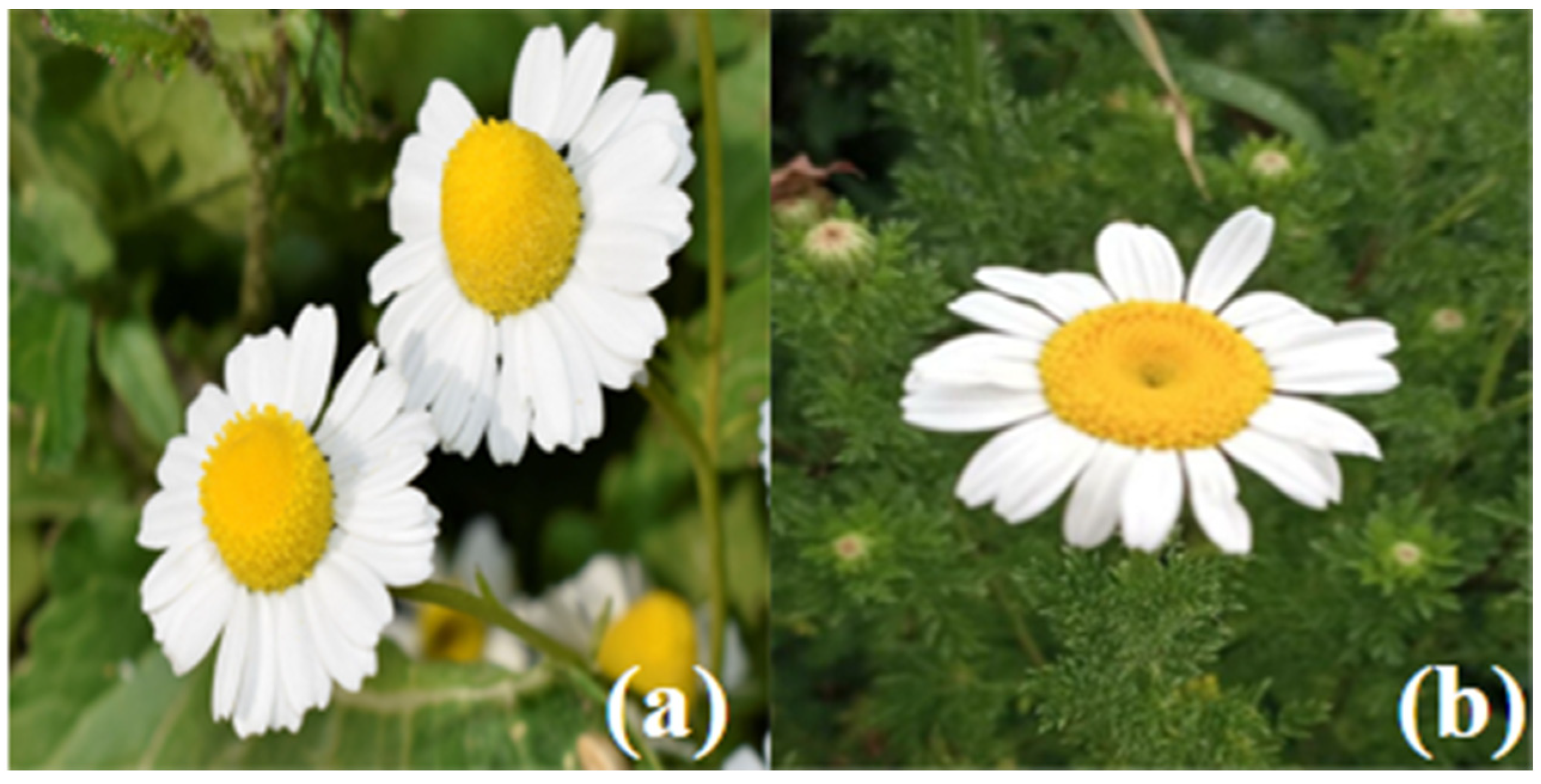
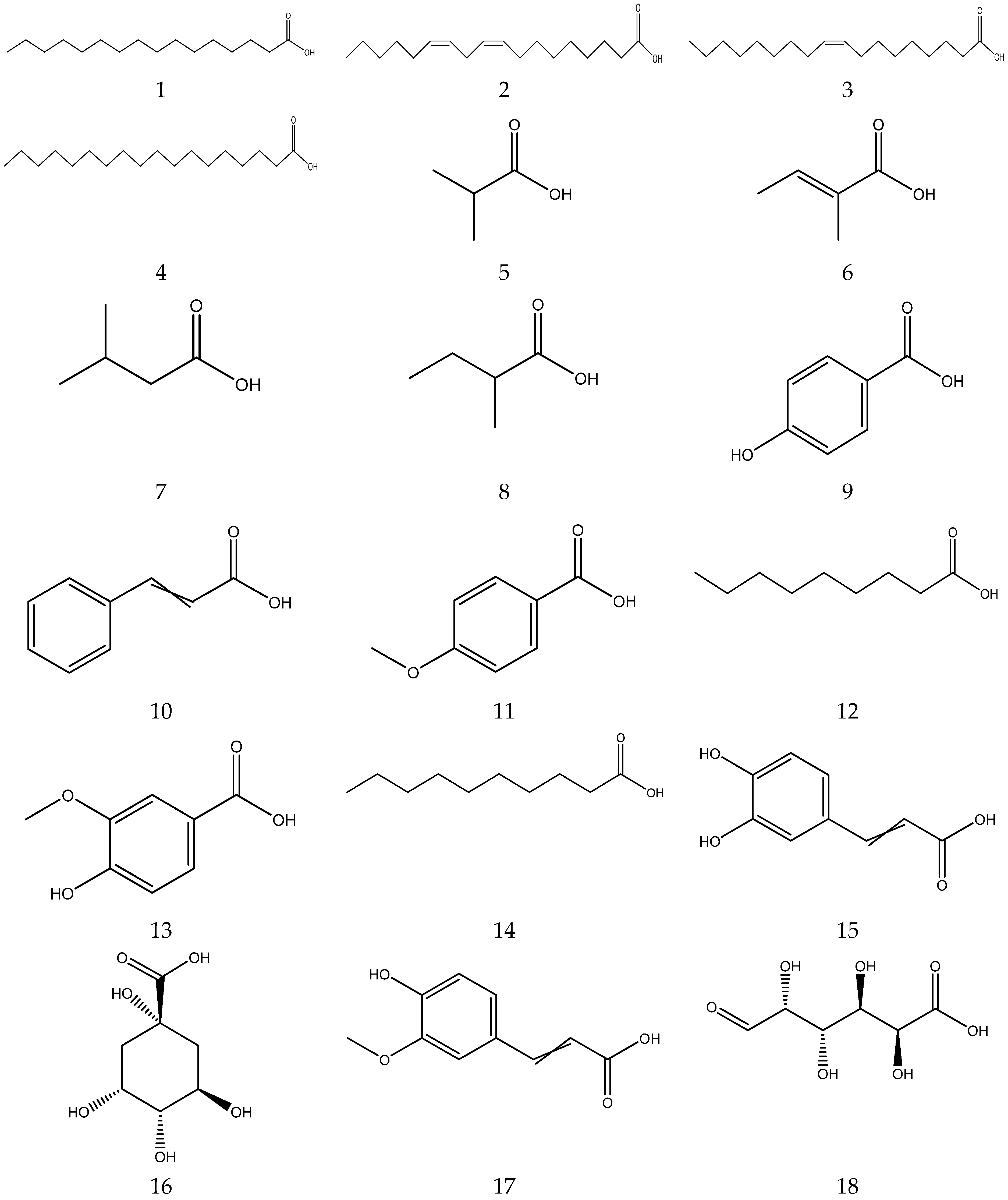
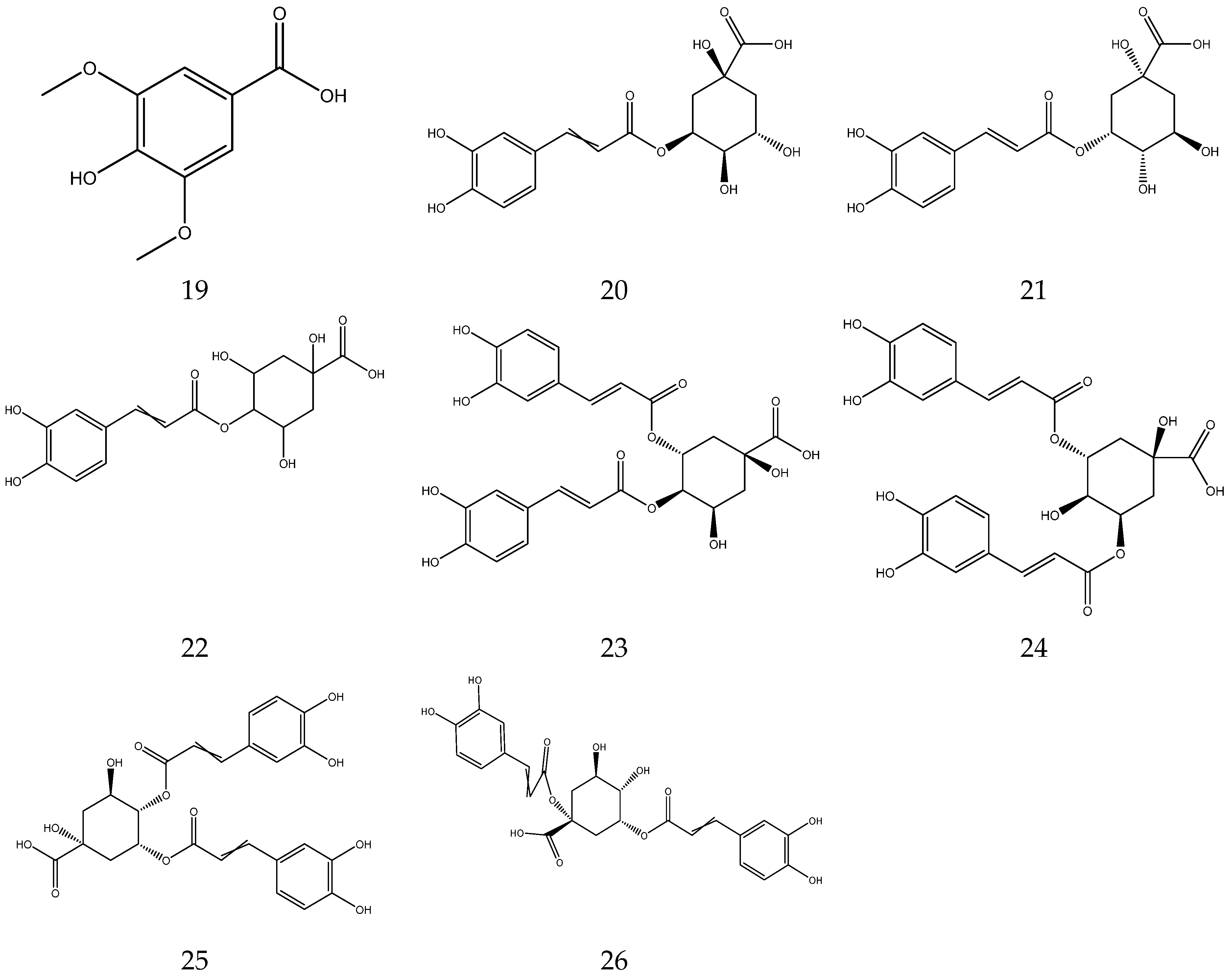
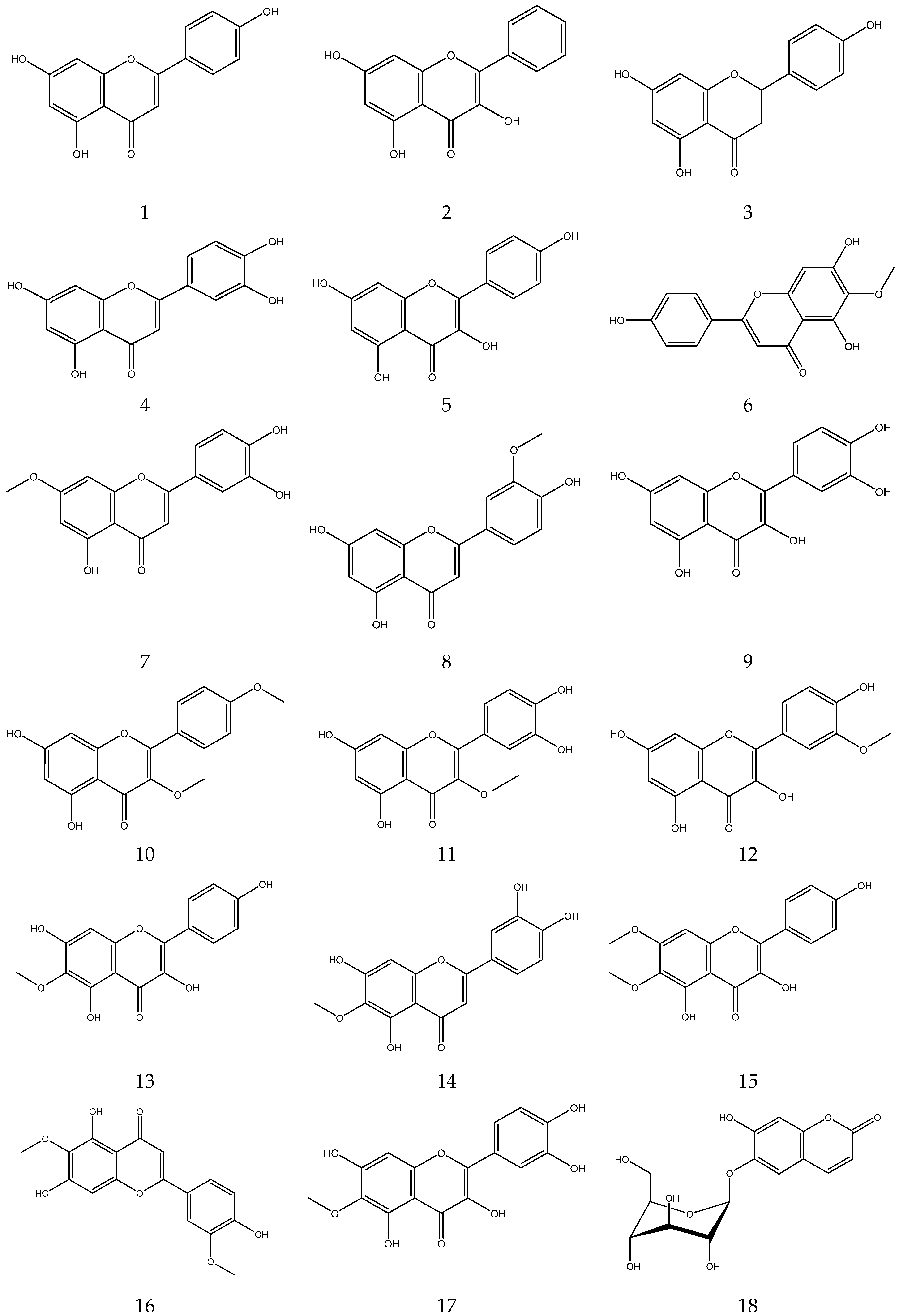
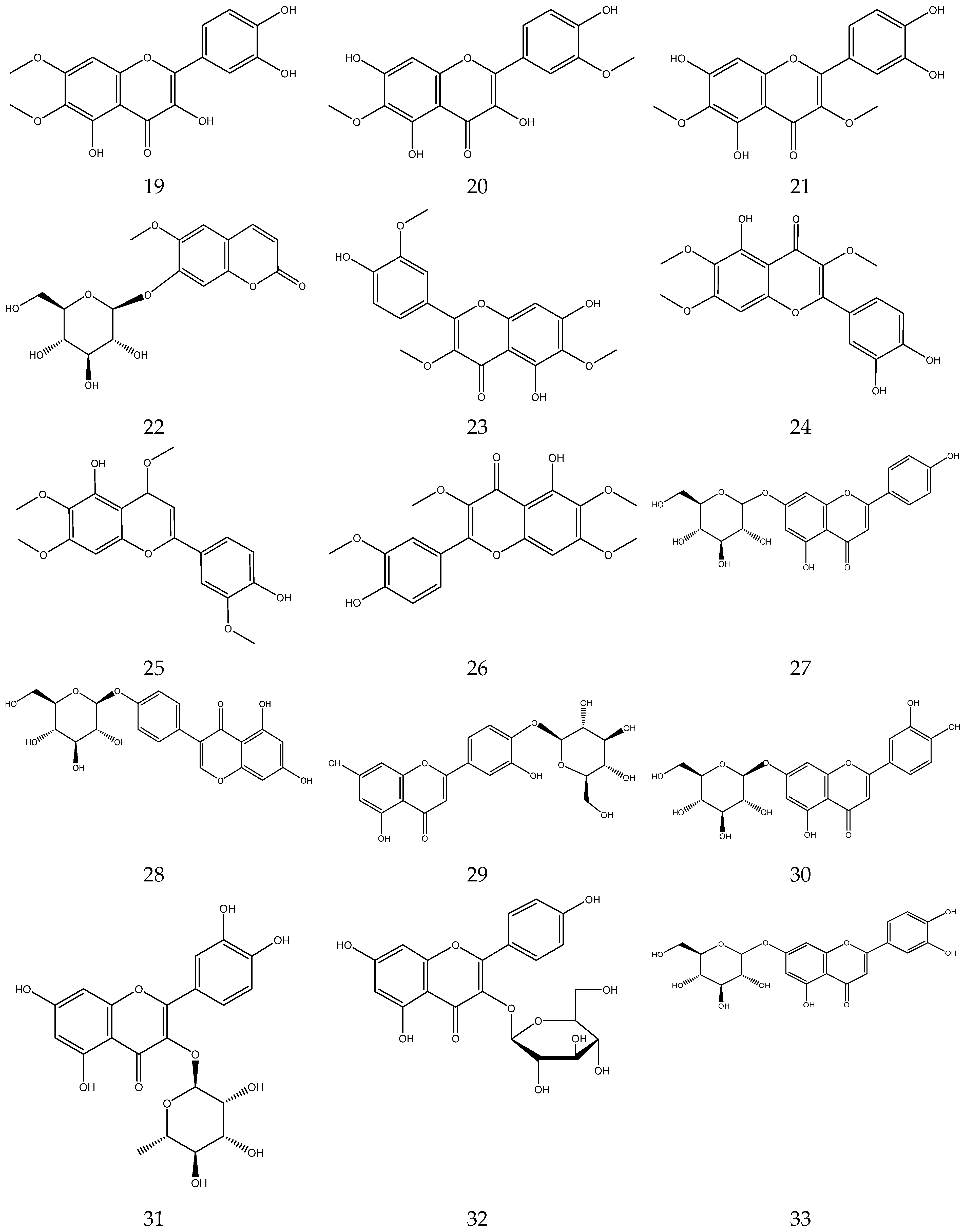
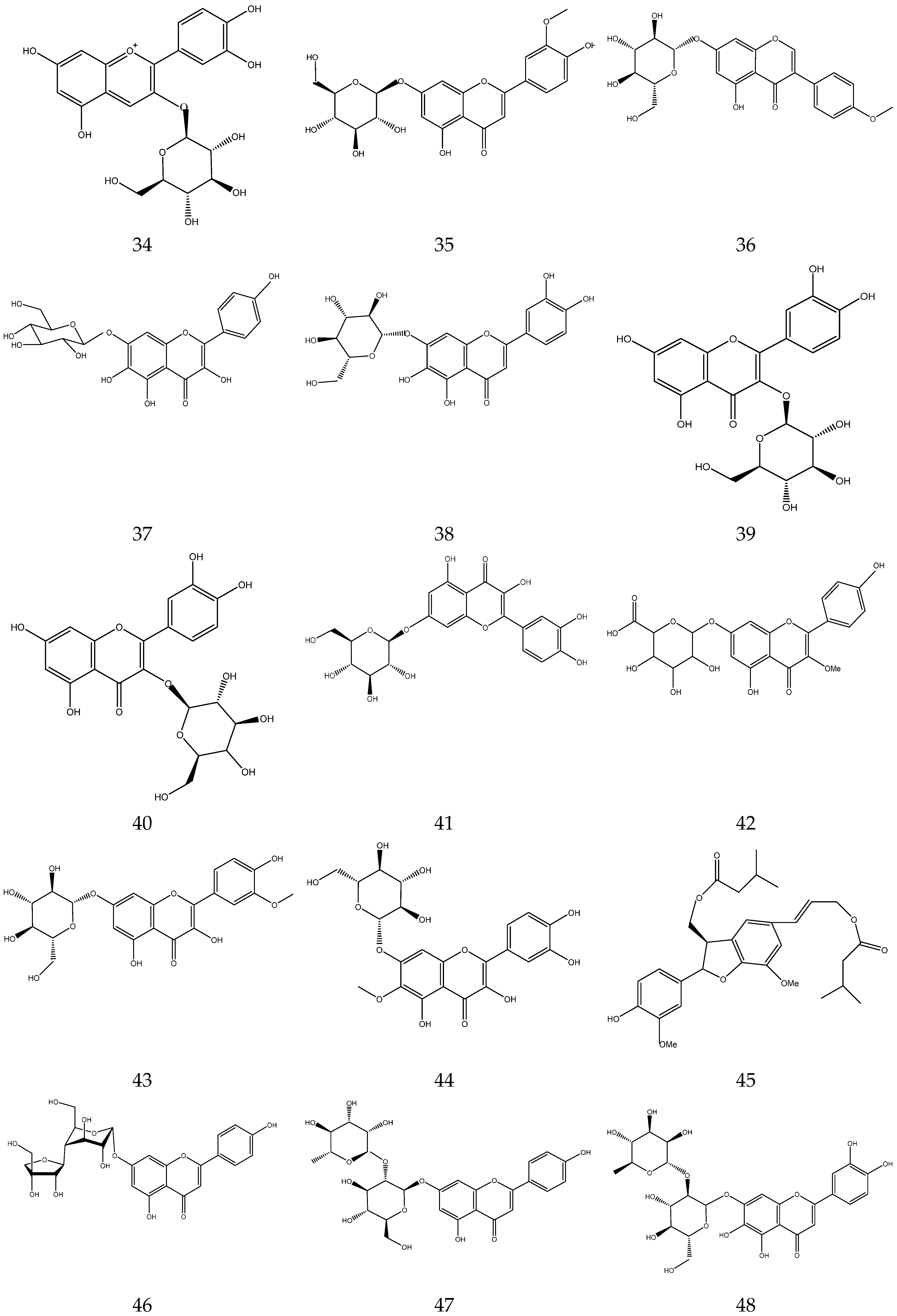
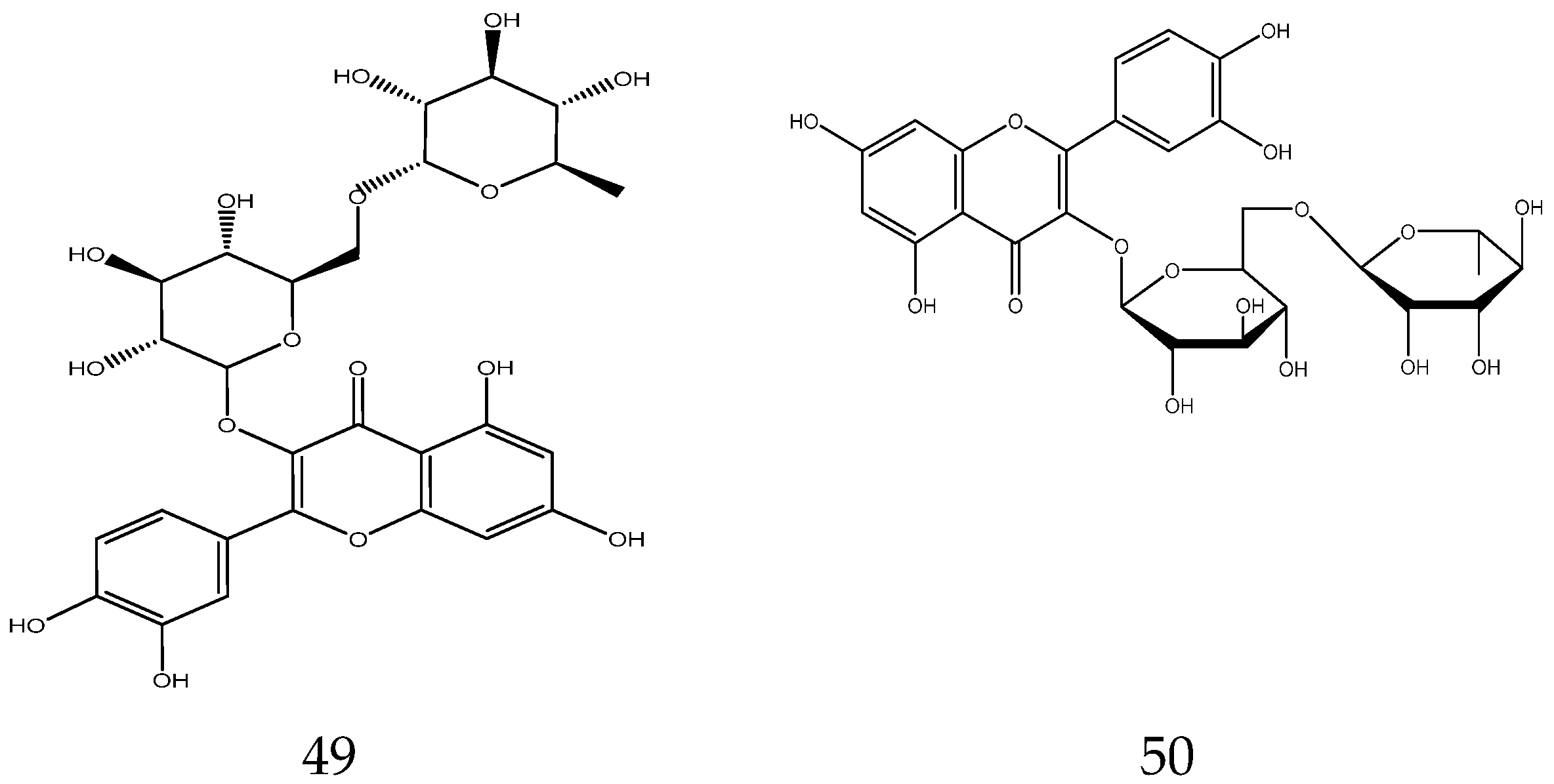
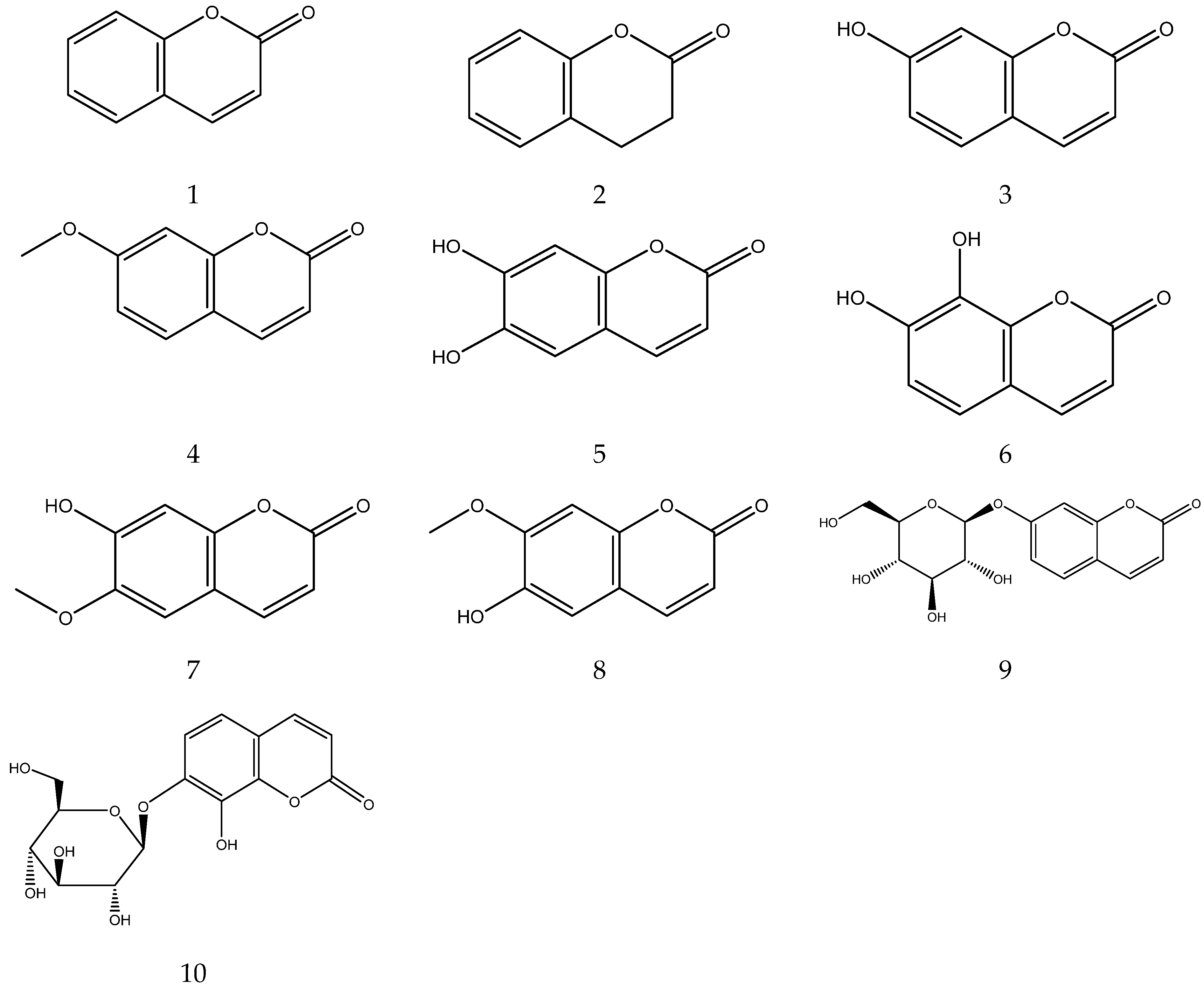
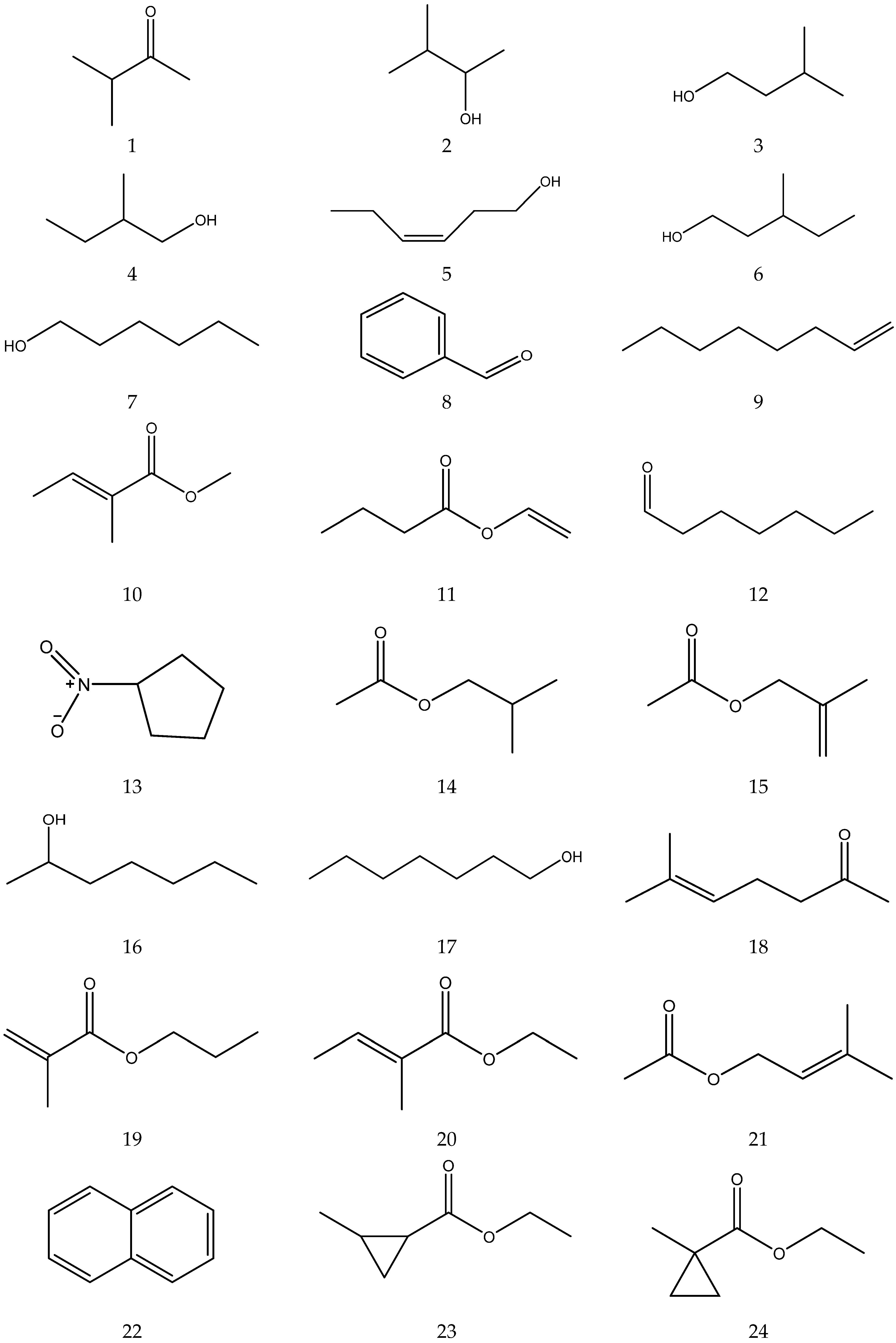
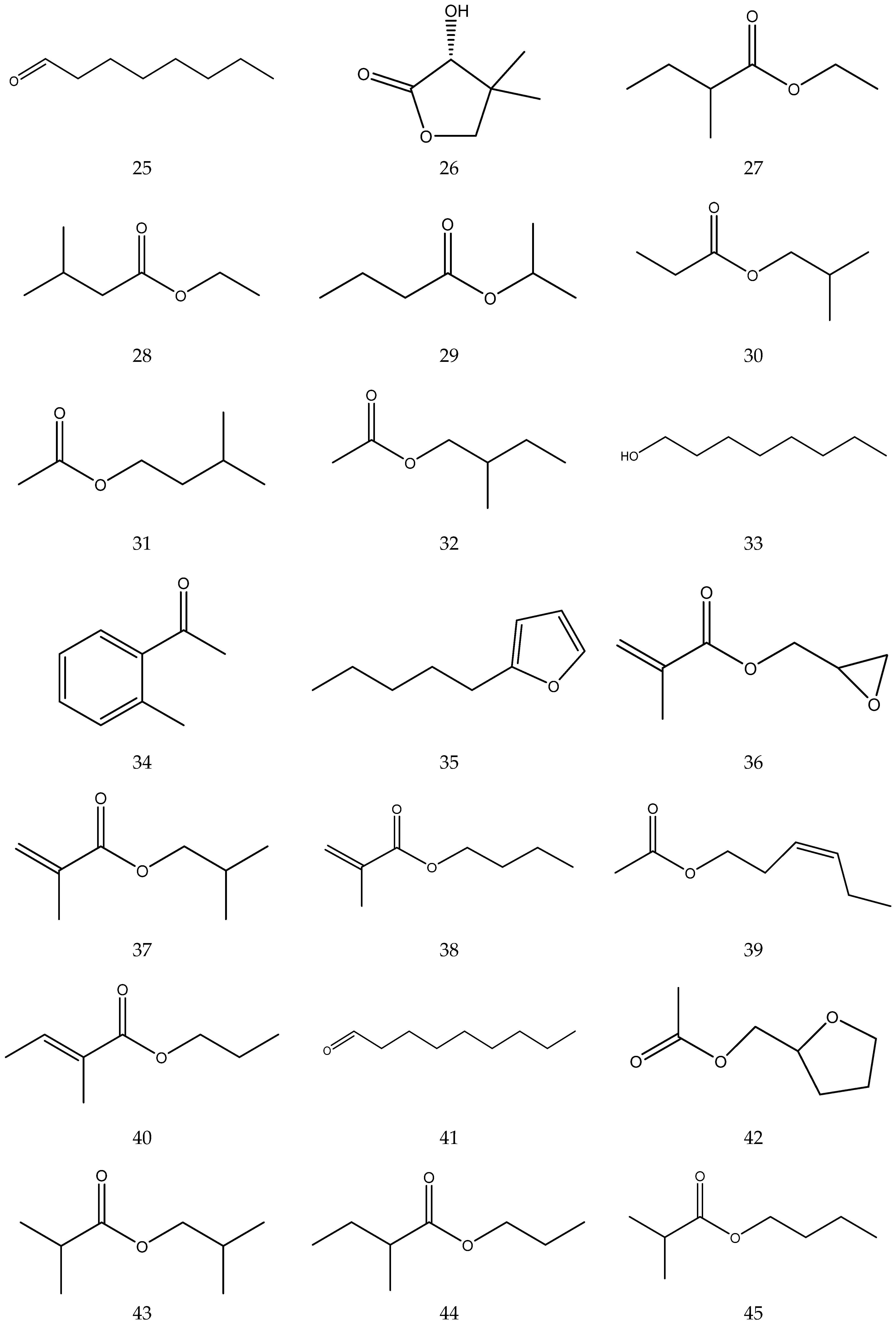

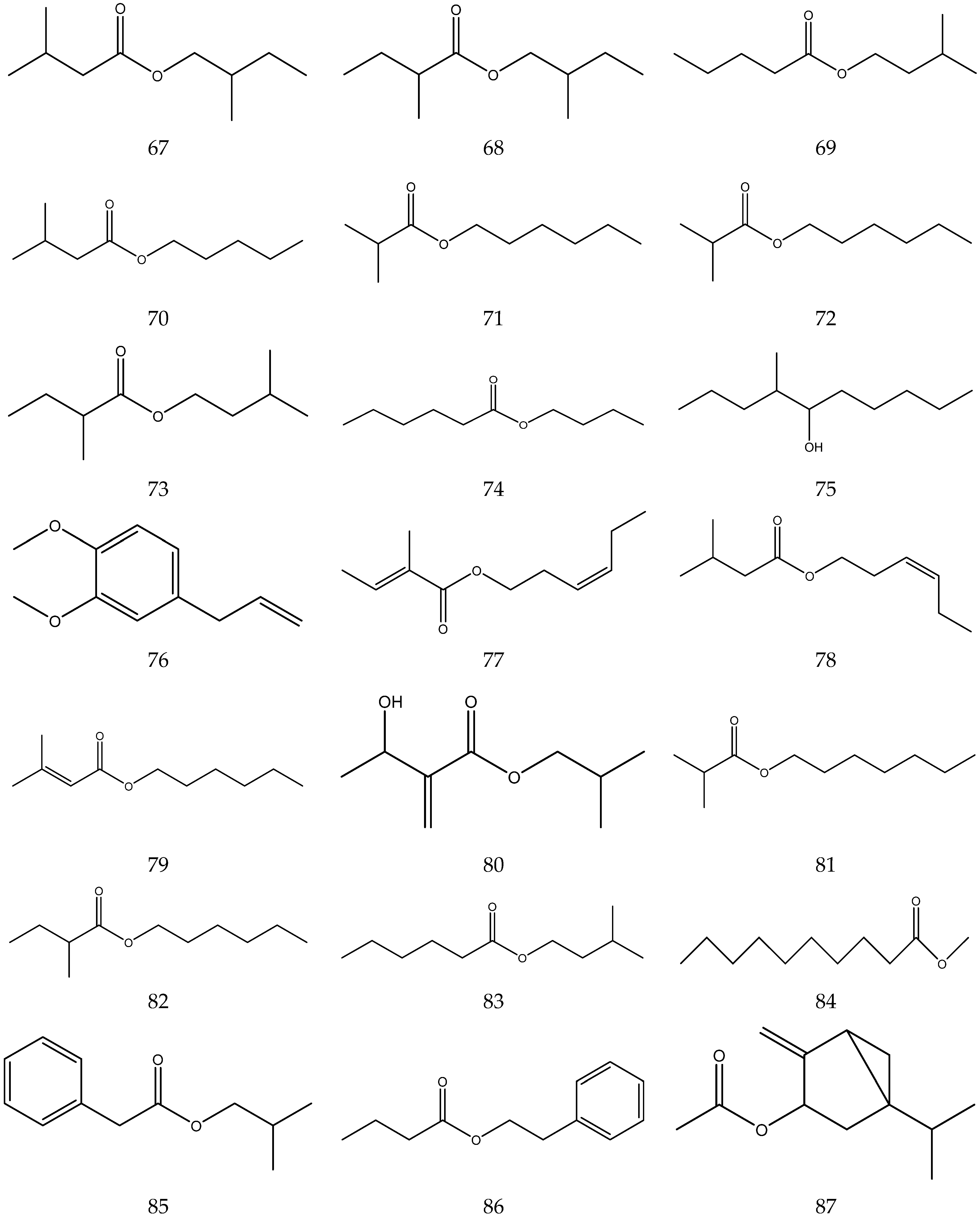
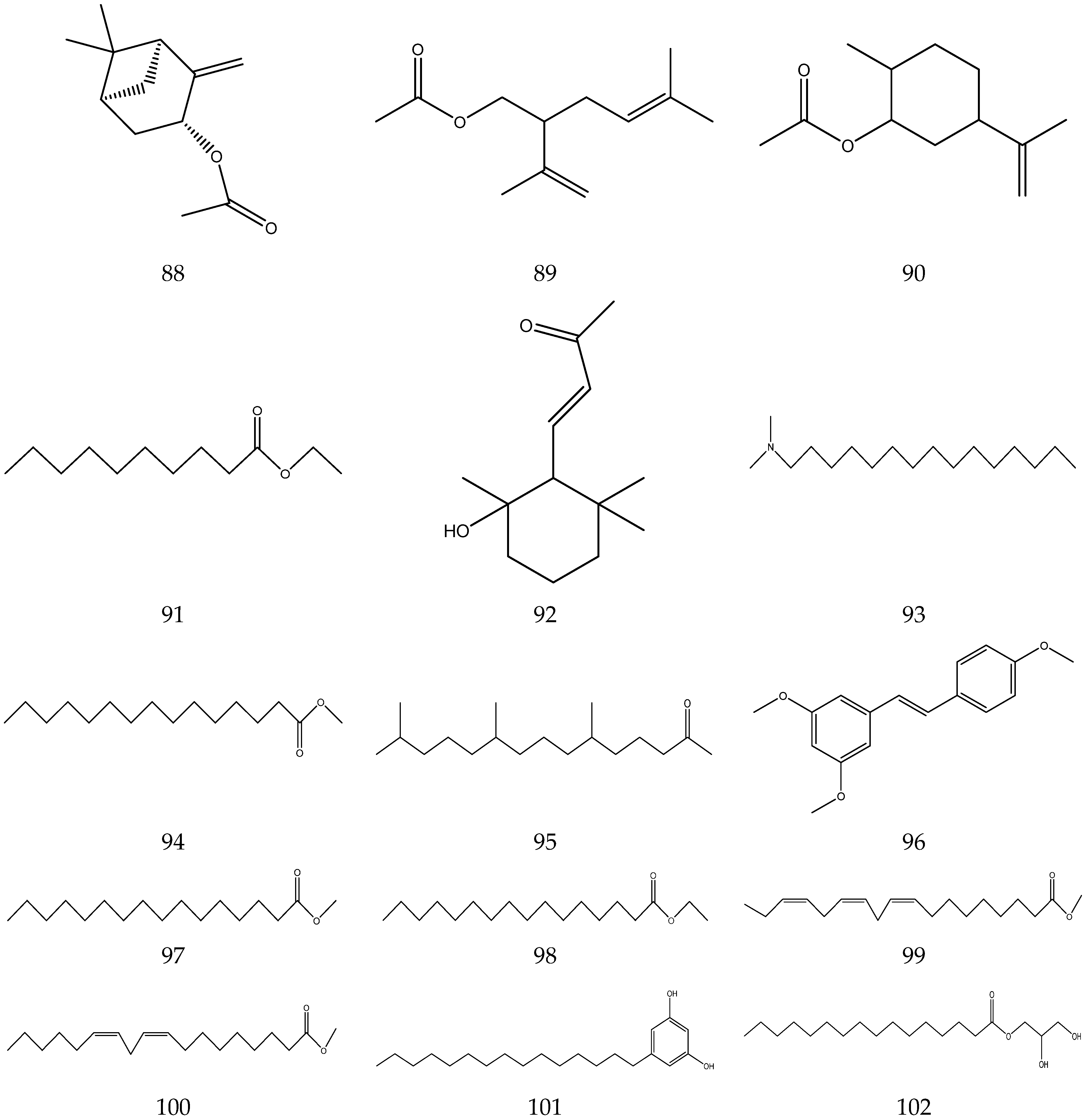
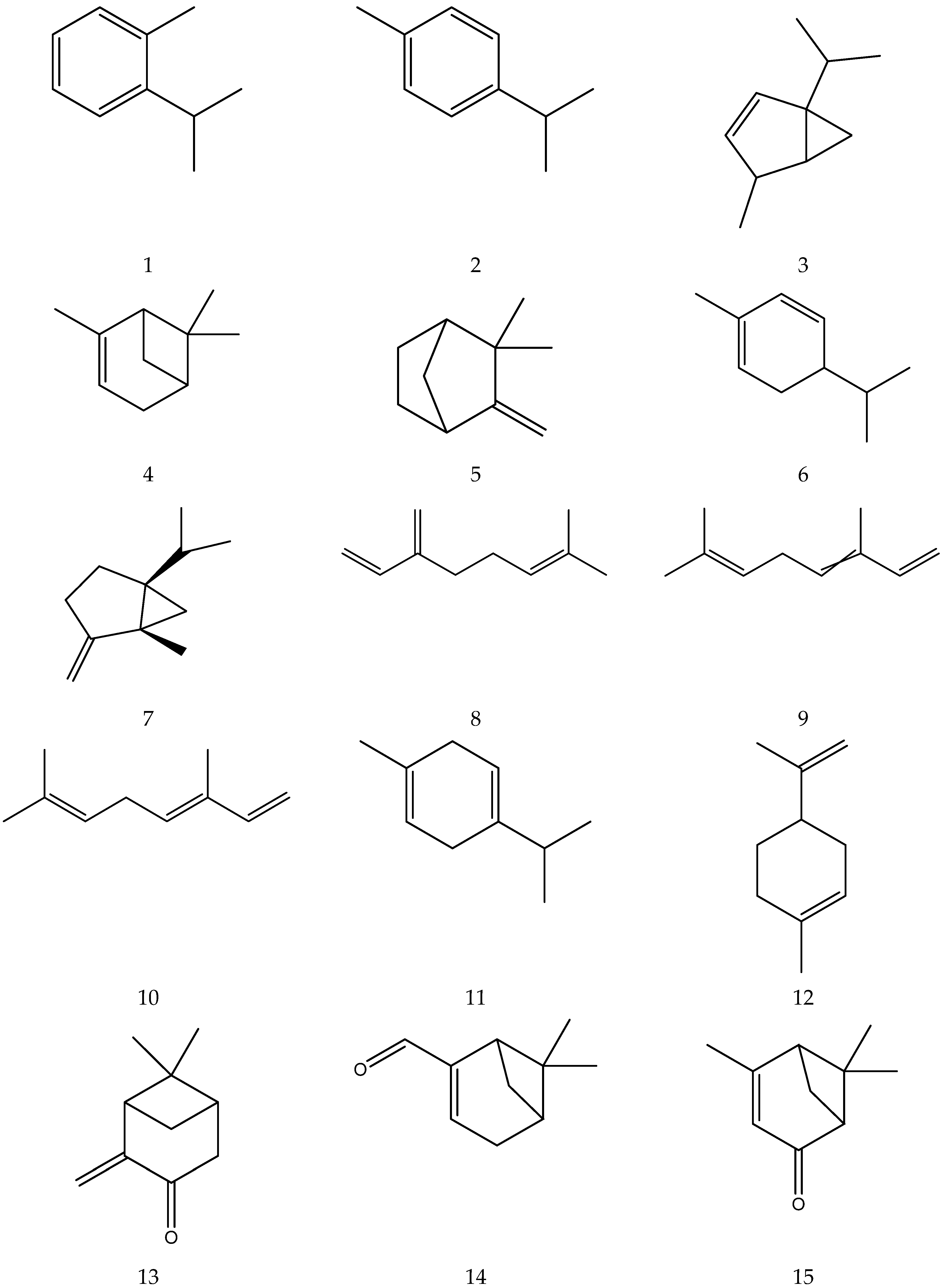
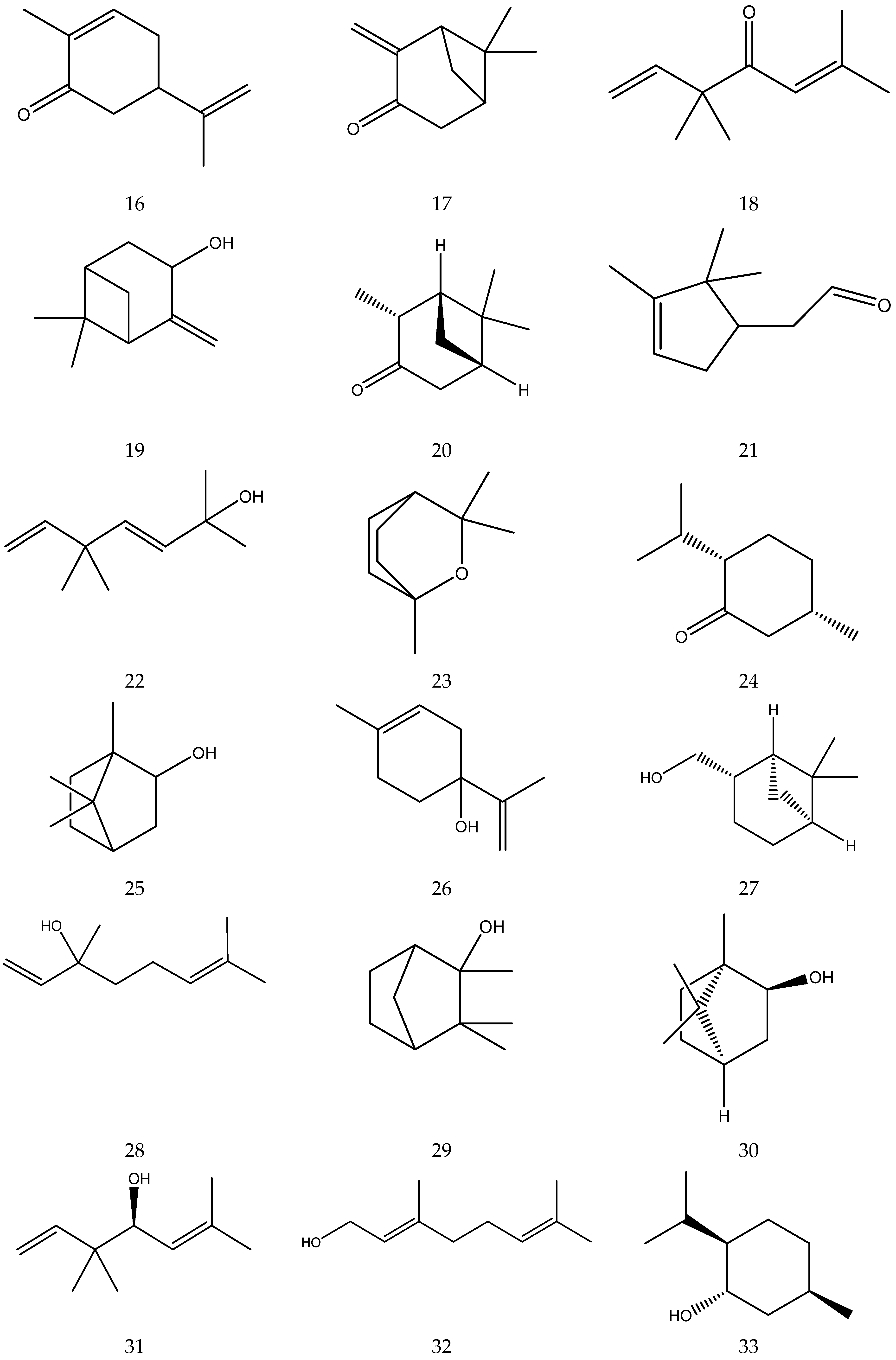
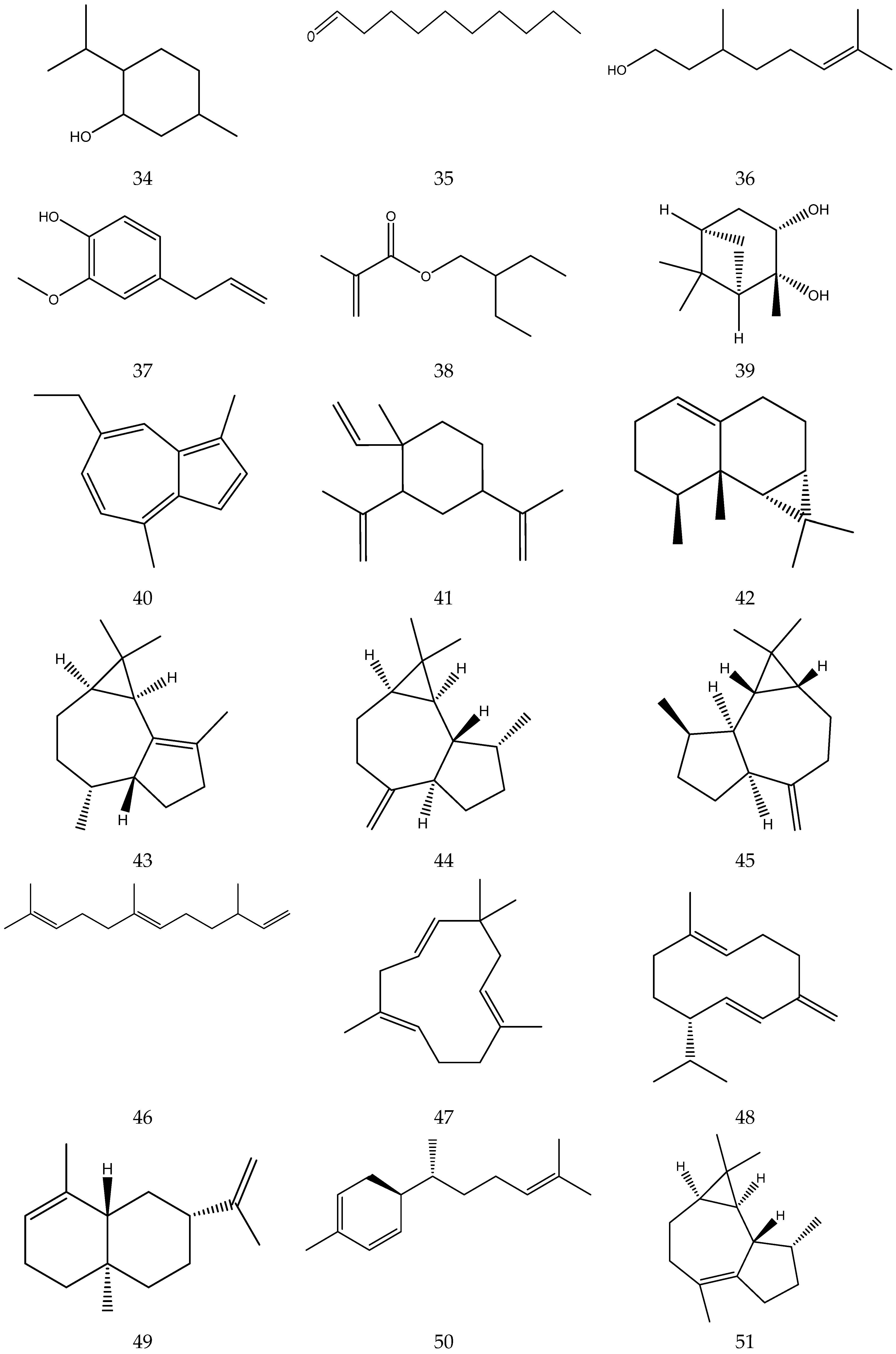



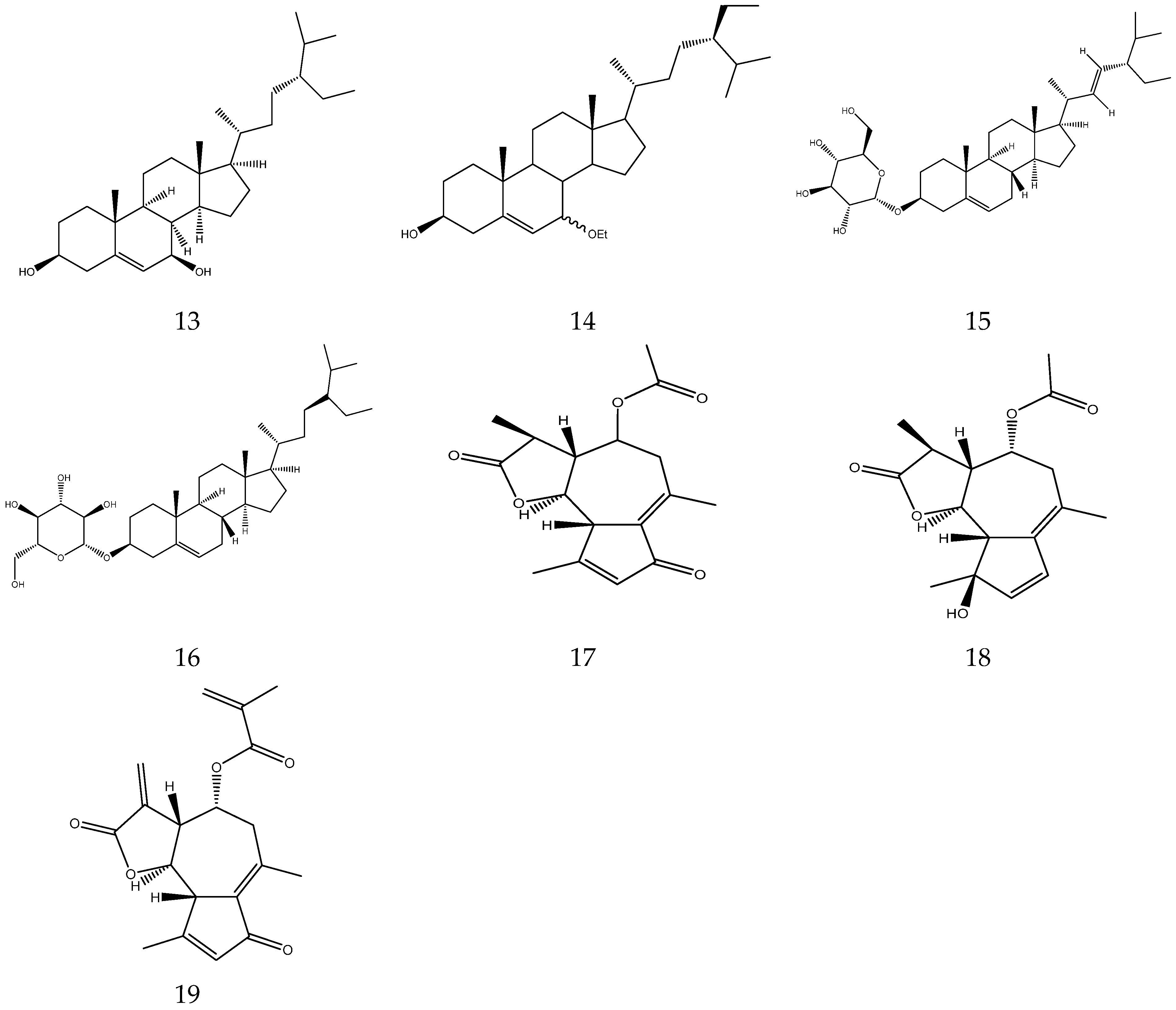
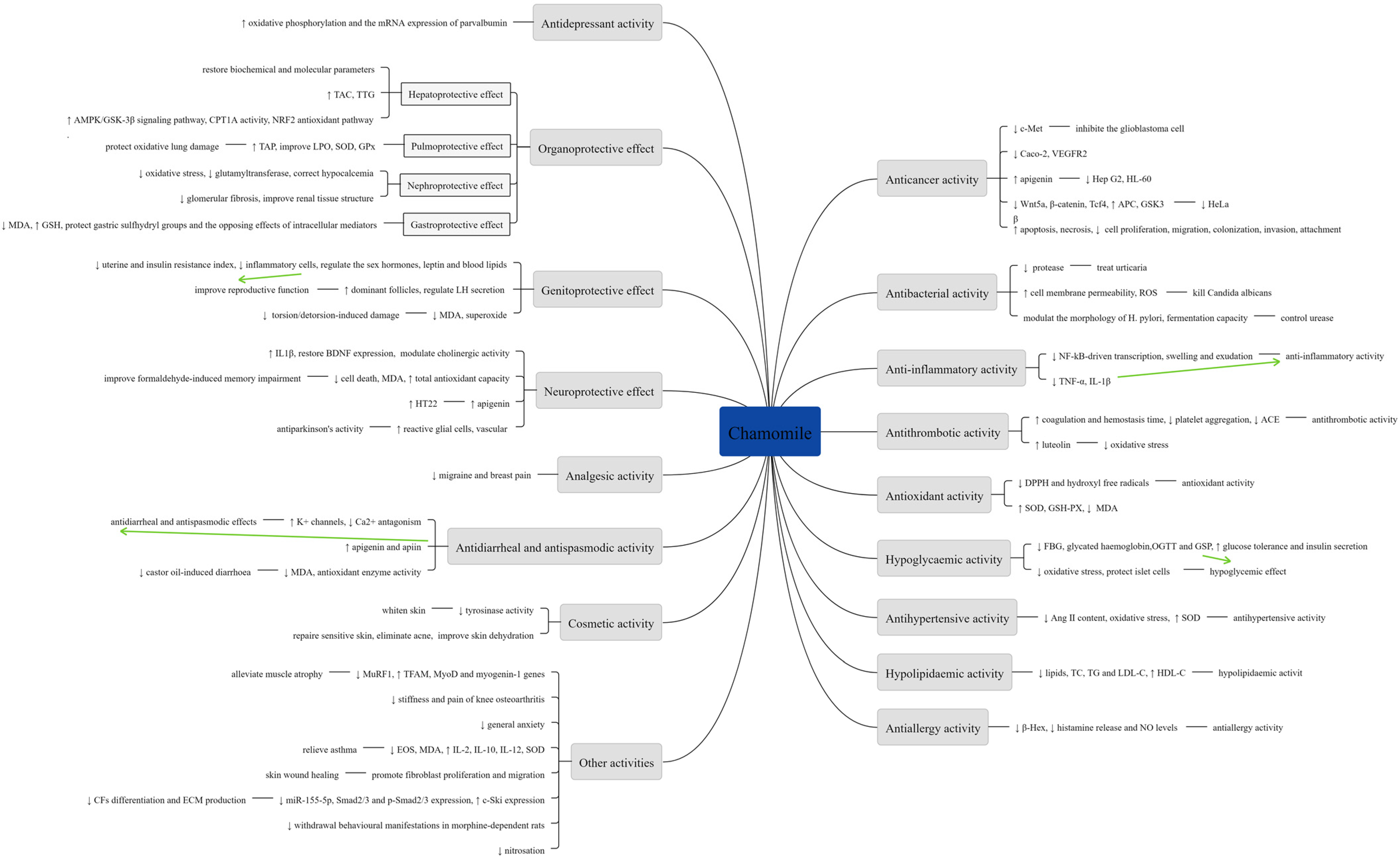
| No. | The Name or Origin of Traditional Uses | Main Components | Usage | Countries | Reference |
|---|---|---|---|---|---|
| 1 | Chamomile tea | Matricaria chamomilla L. | Clear away heat, eyesight, hypotensive and soothe the nerves and sleep | Turkey, China, Germany and other places | [7,18,25] |
| 2 | Honey chamomile tea | Matricaria chamomilla L., Citrus limon (L.) Osbeck, honey | Lower the level of high blood pressure, detoxify, and fight inflammation. | China | [22] |
| 3 | Medicinal Aroma | Matricaria chamomilla L., Rosa rugosa Thunb., Lavandula angustifolia Mill., Lindera benzoin (L.) Blume, Citrus medica L., Salvia japonica Thunb., Nardostachys jatamansi (D.Don) DC., Melissa officinalis L., Pogostemon cablin (Blanco) Benth. | Soothes the nerves | China | [26] |
| 5 | Qingdan Capsules | Matricaria chamomilla L., Curcuma aromatica Salisb., Taraxacum mongolicum Hand.-Mazz., Gardenia jasminoides J.Ellis, Artemisia capillaris Thunb., Paeonia lactiflora Pall., Lysimachia christinae Hance, Poria cocos (Schw.) Wolf., Citrus sinensis (L.) Osbeck | Clears gallbladder | China | [27] |
| 6 | Anti-itch bath | Matricaria chamomilla L., Allium sativum L., Squalane | Anti-itch | China | [17] |
| 7 | Anti-inflammatory bath | Matricaria chamomilla L., Ligusticum striatum DC., Angelica sinensis (Oliv.) Diels, Citrus × aurantium L. | Anti-inflammation | China | [17] |
| 8 | Chinese herbal bath | Matricaria chamomilla L., Ligusticum striatum DC., Angelica sinensis (Oliv.) Diels, Adenophora stricta Miq., Citrus sinensis (L.) Osbeck | Treats rheumatoid arthritis | Japan | [28] |
| 9 | Sunscreen skin care products | Matricaria chamomilla L., Plumeria alba L., Mosla chinensis Maxim., Rheum palmatum L., Glycyrrhiza uralensis Fisch., Mentha canadensis L. | Sun protection | China | [29] |
| 10 | Facial soap | Matricaria chamomilla L., Citrus sinensis (L.) Osbeck, Angelica sinensis (Oliv.) Diels, Paeonia × suffruticosa Andrews, Paeonia lactiflora Pall., almond oil | Improves dull and rough skin | Japan | [30] |
| 11 | Skin repair lotion | Matricaria chamomilla L., Portulaca oleracea L., Glycyrrhiza uralensis Fisch., Centella asiatica (L.) Urb. | Relieves skin irritation | China | [31] |
| 12 | Antiviral traditional Chinese medicine composition | Matricaria chamomilla L., Lonicera japonica Thunb., Fagopyrum dibotrys (D. Don) Hara, Houttuynia cordata Thunb., Prunella vulgaris L., Morus alba L., Dendranthema morifolium (Ramat.) Tzvelev, Perilla frutescens (L.) Britton, Pogostemon cablin (Blanco) Benth., Mentha canadensis L., Radix Puerariae, Glycyrrhiza uralensis Fisch., Zingiber officinale Roscoe, Ziziphus jujuba Mill. | Antiviral or prevents viral diseases | China | [32] |
| Categories | No | Name | Molecular Formula | Relative Molecular Mass | References |
|---|---|---|---|---|---|
| Primary metabolites | 1 | Palmitic acid | C16H32O2 | 256.42 | [33] |
| 2 | Linoleic acid | C18H32O2 | 280.45 | [33] | |
| 3 | Oleic acid | C18H34O2 | 282.46 | [33] | |
| 4 | Stearic acid | C18H36O2 | 284.48 | [33] | |
| Secondary metabolites | 5 | Isobutyric acid | C4H8O2 | 88.11 | [36] |
| 6 | Tiglic acid | C5H8O2 | 100.12 | [36] | |
| 7 | Isovaleric acid | C5H10O2 | 102.13 | [36] | |
| 8 | D,L-2-Methylbutyric acid | C5H10O2 | 102.13 | [36] | |
| 9 | 4-Hydroxybenzoic acid | C7H6O3 | 140.11 | [35] | |
| 10 | Cinnamic acid | C9H8O2 | 149.02 | [35] | |
| 11 | Anisic acid | C8H8O3 | 152.15 | [33] | |
| 12 | Nonanoic acid | C9H18O2 | 158.24 | [36] | |
| 13 | Vanillic acid | C8H8O4 | 168.15 | [33] | |
| 14 | Decanoic acid | C10H20O2 | 172.26 | [36] | |
| 15 | Caffeic acid | C9H8O4 | 179.04 | [34] | |
| 16 | Quinic acid | C7H12O6 | 191.06 | [35] | |
| 17 | Ferulic acid | C10H10O4 | 193.05 | [35] | |
| 18 | Galacturonic acid | C6H10O7 | 194.14 | [33] | |
| 19 | Syringic acid | C9H10O5 | 198.17 | [33] | |
| 20 | Chlorogein acid | C16H18O9 | 353.09 | [34] | |
| 21 | Neochlorogenic acid | C16H18O9 | 353.09 | [34] | |
| 22 | Cryptochlorogenic acid | C16H18O9 | 354.31 | [38] | |
| 23 | Isochlorogenic acid B | C25H24O12 | 516.40 | [37] | |
| 24 | Isochlorogenic acid A | C25H24O12 | 516.45 | [38] | |
| 25 | Isochlorogenic acid C | C25H24O12 | 516.46 | [35] | |
| 26 | 1,5-Dicaffeoylquinic acid | C25H24O12 | 517.13 | [35] |
| No | Name | Molecular Formula | Relative Molecular Mass | References |
|---|---|---|---|---|
| 1 | Apigenin | C15H10O5 | 269.05 | [37] |
| 2 | Galangin | C15H10O5 | 270.24 | [35] |
| 3 | Naringenin | C15H12O5 | 272.25 | [33] |
| 4 | Luteolin | C15H10O6 | 286.24 | [33] |
| 5 | Kaempferol | C15H10O6 | 286.24 | [35] |
| 6 | Hispidulin | C16H12O6 | 300.26 | [35] |
| 7 | Hydroxygenkwanin | C16H12O6 | 300.26 | [35] |
| 8 | Chrysoeriol | C16H12O6 | 300.26 | [33] |
| 9 | Quercetin | C15H10O7 | 302.23 | [35] |
| 10 | Ermanin | C17H14O6 | 314.29 | [35] |
| 11 | 3-O-Methylquercetin | C16H12O7 | 316.26 | [33] |
| 12 | 3-Methylquercetin/Isorhamnetin | C16H12O7 | 316.26 | [33] |
| 13 | 6-Methoxykaempfero | C16H12O7 | 316.26 | [35] |
| 14 | Eupafolin | C16H12O7 | 316.26 | [35] |
| 15 | Eupalitin | C17H14O7 | 330.29 | [33] |
| 16 | Jaceosidin | C17H14O7 | 330.29 | [35] |
| 17 | Patuletin | C16H12O8 | 332.26 | [33] |
| 18 | Esculin | C15H16O9 | 339.07 | [34] |
| 19 | Eupatoletin | C17H14O8 | 346.29 | [33] |
| 20 | Spinacetin | C17H14O8 | 346.29 | [33] |
| 21 | Axillarin | C17H14O8 | 346.29 | [33] |
| 22 | Scopolin | C16H18O9 | 355.10 | [34] |
| 23 | Jaceidin | C18H16O8 | 360.31 | [33] |
| 24 | Chrysosplenol D | C18H16O8 | 360.31 | [33] |
| 25 | 4′,5-Di-hydroxy-3,3′,6,7-tetra-methoxy-flavone | C19H18O8 | 374.34 | [33] |
| 26 | Chrysosplenetin B | C19H18O8 | 374.34 | [33] |
| 27 | Cosmosiin | C21H20O10 | 431.10 | [33] |
| 28 | Sophoricoside | C21H20O10 | 433.11 | [34] |
| 29 | Luteolin-4′-β-glucoside | C21H20O11 | 448.38 | [40] |
| 30 | Cynaroside | C21H20O11 | 448.38 | [40] |
| 31 | Quercitrin | C21H20O11 | 448.38 | [33] |
| 32 | Astragalin | C21H20O11 | 448.38 | [33] |
| 33 | Cynaroside | C21H20O11 | 449.11 | [33] |
| 34 | Cyanidin-3-O-glucoside | C21H21O11 | 449.11 | [34] |
| 35 | Chrysoeriol-β-glucoside | C22H22O11 | 462.40 | [33] |
| 36 | Pratensein-7-O-glucoside | C22H22O11 | 463.12 | [34] |
| 37 | 7-O-(β-D-glucopyranosyl)-galactin | C21H20O12 | 464.20 | [7] |
| 38 | 6-Hydroxy-luteolin-7-glucoside | C21H20O12 | 464.38 | [33] |
| 39 | Quercetin-3-glucoside | C21H20O12 | 464.38 | [33] |
| 40 | Hyperoside | C21H20O12 | 464.38 | [33] |
| 41 | Quercimeritrin | C21H20O12 | 466.39 | [33] |
| 42 | Isokaempferol-7-O-glucuronide | C22H20O12 | 476.21 | [7] |
| 43 | Isorhamnetin-7-O-β-glucoside | C22H22O12 | 478.41 | [33] |
| 44 | Patulitrin | C22H22O13 | 494.40 | [33] |
| 45 | Dimerized coniferyl isovalerate | C30H38O8 | 526.30 | [7] |
| 46 | Apiin | C26H28O14 | 564.49 | [33] |
| 47 | Rhoifolin | C27H30O14 | 578.52 | [34] |
| 48 | Luteolin-7-O-β-rutinoside | C27H30O15 | 594.52 | [33] |
| 49 | Quercetin-3-O-rutinoside | C27H30O16 | 610.52 | [33] |
| 50 | Rutin | C27H30O16 | 610.52 | [33] |
| No | Name | Molecular Formula | Relative Molecular Mass | References |
|---|---|---|---|---|
| 1 | Coumarin | C9H6O2 | 146.14 | [33] |
| 2 | 3,4-Dihydrocoumarin | C9H8O2 | 148.16 | [38] |
| 3 | Umbelliferone | C9H6O3 | 162.14 | [43] |
| 4 | 7-Methoxycoumarin | C10H8O3 | 177.05 | [34] |
| 5 | Esculetin | C9H6O4 | 178.14 | [33] |
| 6 | Daphnetin | C9H6O4 | 178.14 | [43] |
| 7 | Scopoletin | C10H8O4 | 192.17 | [33] |
| 8 | Isoscopoletin | C10H8O4 | 192.17 | [33] |
| 9 | Skimmin | C15H16O8 | 324.28 | [43] |
| 10 | Daphnin | C15H16O9 | 340.28 | [43] |
| No | Name | Molecular Formula | Relative Molecular Mass | References |
|---|---|---|---|---|
| 1 | 3-Methyl-2-butanone | C5H10O | 86.13 | [36] |
| 2 | 3-Methyl-2-butanol | C5H12O | 88.15 | [36] |
| 3 | Isoamyl alcohol | C5H12O | 88.15 | [36] |
| 4 | 2-Methyl-1-butanol | C5H12O | 88.15 | [36] |
| 5 | Leaf alcohol | C6H12O | 100.16 | [36] |
| 6 | 3-Methyl-1-pentanol | C6H14O | 102.17 | [36] |
| 7 | Hexyl alcohol | C6H14O | 102.17 | [36] |
| 8 | Benzaldehyde | C7H6O | 106.12 | [36] |
| 9 | 1-Octene | C8H16 | 112.21 | [36] |
| 10 | Methyl tiglate | C6H10O2 | 114.14 | [36] |
| 11 | Vinyl butyrate | C6H10O2 | 114.14 | [33] |
| 12 | Heptaldehyde | C7H14O | 114.19 | [36] |
| 13 | Cyclopentane, nitro- | C5H9NO2 | 115.13 | [33] |
| 14 | Isobutyl acetate | C6H12O2 | 116.16 | [36] |
| 15 | Methallyl acetate | C6H12O2 | 116.16 | [36] |
| 16 | 2-Heptanol | C7H16O | 116.20 | [36] |
| 17 | Heptylalcohol | C7H16O | 116.20 | [36] |
| 18 | Methylheptenone | C8H14O | 126.20 | [36] |
| 19 | Propyl methacrylate | C7H12O2 | 128.17 | [36] |
| 20 | Ethyl tiglate | C7H12O2 | 128.17 | [36] |
| 21 | Prenyl acetate | C7H12O2 | 128.17 | [36] |
| 22 | Naphthalene | C10H8 | 128.17 | [36] |
| 23 | Ethyl 2-methylcyclopropanecarboxylate | C7H12O2 | 128.17 | [33] |
| 24 | Ethyl 1-methylcyclopropanecarboxylate | C7H12O2 | 128.17 | [33] |
| 25 | Octanal | C8H16O | 128.21 | [36] |
| 26 | Dihydro-3-hydroxy-4,4-dimethyl-, (R)-2(3H)-Furanone | C6H10O3 | 130.14 | [36] |
| 27 | Ethyl 2-methylbutyrate | C7H14O2 | 130.18 | [35] |
| 28 | Ethyl isovalerate/Ethyl 3-methylbutanoate | C7H14O2 | 130.18 | [35] |
| 29 | Isopropyl butyrate | C7H14O2 | 130.18 | [36] |
| 30 | Isobutyl propionate | C7H14O2 | 130.18 | [36] |
| 31 | Isoamyl acetate | C7H14O2 | 130.18 | [36] |
| 32 | 2-Methylbutyl acetate | C7H14O2 | 130.18 | [36] |
| 33 | 1-Octanol | C8H18O | 130.23 | [36] |
| 34 | 2′-Methylacetophenone | C9H10O | 134.18 | [36] |
| 35 | 2-Pentylfuran | C9H14O | 138.21 | [36] |
| 36 | 2-Propenoic acid, 2-methyl-, oxiranylmethyl ester | C7H10O3 | 142.15 | [33] |
| 37 | Isobutyl methacrylate | C8H14O2 | 142.20 | [33] |
| 38 | Butyl methacrylate | C8H14O2 | 142.20 | [36] |
| 39 | Leaf acetate | C8H14O2 | 142.20 | [36] |
| 40 | Propyl tiglate | C8H14O2 | 142.20 | [36] |
| 41 | 1-Nonanal | C9H18O | 142.24 | [36] |
| 42 | 2-Furanmethanol, tetrahydro-, acetate | C7H12O3 | 144.17 | [33] |
| 43 | Isobutyl isobutyrate | C8H16O2 | 144.21 | [33] |
| 44 | Propyl 2-methylbutanoate | C8H16O2 | 144.21 | [36] |
| 45 | Butyl isobutyrate | C8H16O2 | 144.21 | [36] |
| 46 | Isoamyl propionate | C8H16O2 | 144.21 | [36] |
| 47 | Hexyl acetate | C8H16O2 | 144.21 | [36] |
| 48 | 1-Nonanol | C9H20O | 144.25 | [36] |
| 49 | Benzyl acetate | C9H10O2 | 150.17 | [36] |
| 50 | Benzaldehyde dimethyl acetal | C9H12O2 | 152.19 | [36] |
| 51 | Cyclobutanecarboxylic acid, cyclobutyl ester | C9H14O2 | 154.21 | [33] |
| 52 | Iso-amyl methacrylae | C9H16O2 | 156.22 | [36] |
| 53 | Isobutyl tiglate | C9H16O2 | 156.22 | [36] |
| 54 | Cis-3-hexexnyl propionate | C9H16O2 | 156.22 | [36] |
| 55 | Butyric anhydride | C8H14O3 | 158.19 | [33] |
| 56 | Isobutyl 2-methylbutyrate | C9H18O2 | 158.24 | [36] |
| 57 | Isobutyl isovalerate | C9H18O2 | 158.24 | [36] |
| 58 | Isopentyl isobutyrate | C9H18O2 | 158.24 | [36] |
| 59 | 2-Methyl-butanoic acid butyl ester | C9H18O2 | 158.24 | [37] |
| 60 | Butyl isovalerate | C9H18O2 | 158.24 | [36] |
| 61 | Hexyl propionate | C9H18O2 | 158.24 | [36] |
| 62 | Amyl butyrate | C9H18O2 | 158.24 | [36] |
| 63 | 2-Methylbutyl isobutyrate | C9H18O2 | 158.24 | [33] |
| 64 | Phenethyl acetate | C10H12O2 | 164.20 | [36] |
| 65 | 2-Propenoic acid, 2-methyl-,(tetrahydro-2-furanyl) methyl ester | C9H14O3 | 170.21 | [33] |
| 66 | Isoamyl 2-methyl butyrate | C10H20O2 | 172.26 | [36] |
| 67 | 2-Methylbutyl isovalerate | C10H20O2 | 172.26 | [36] |
| 68 | 2-Methylbutyl 2-methylbutyrate | C10H20O2 | 172.26 | [36] |
| 69 | Pentanoic acid, 3-methylbutyl ester | C10H20O2 | 172.26 | [36] |
| 70 | 3-Methyl-butanoic aci pentyl ester | C10H20O2 | 172.26 | [36] |
| 71 | Hexyl isobutyrate | C10H20O2 | 172.26 | [36] |
| 72 | Hexyl isobutyrate | C10H20O2 | 172.26 | [36] |
| 73 | Butanoic acid, 2-methyl-, 3-methylbutyl ester | C10H20O2 | 172.26 | [33] |
| 74 | Hexanoic acid,2-methylpropyl ester | C10H20O2 | 172.26 | [33] |
| 75 | 4-Methyl-5-decanol | C11H24O | 172.31 | [33] |
| 76 | Methyl eugenol | C11H14O2 | 178.23 | [36] |
| 77 | Cis-3-Hexenyl tiglate | C11H18O2 | 182.26 | [36] |
| 78 | 3-Methyl-, 3-hexenyl ester, (Z)-Butanoic acid | C11H20O2 | 184.27 | [36] |
| 79 | 2-Butenoic acid,3-methyl-, hexyl ester | C11H20O2 | 184.28 | [36] |
| 80 | Isobutyl 3-hydroxy-2-methylenebutanoate | C10H18O3 | 186.25 | [33] |
| 81 | Propanoic acid, 2-methyl-, heptyl ester | C11H22O2 | 186.29 | [36] |
| 82 | Hexyl 2-methylbutyrate | C11H22O2 | 186.29 | [36] |
| 83 | Isopentyl hexanoate | C11H22O2 | 186.29 | [33] |
| 84 | Decanoic acid, methyl ester | C11H22O2 | 186.29 | [33] |
| 85 | Isobutyl phenylacetate | C12H16O2 | 192.25 | [36] |
| 86 | Phenethyl butyrate | C12H16O2 | 192.25 | [36] |
| 87 | Sabinylacetate | C12H18O2 | 194.27 | [36] |
| 88 | (−)-Trans-pinocarvyl acetate | C12H18O2 | 194.27 | [33] |
| 89 | Lavandulyl acetate | C12H20O2 | 196.29 | [36] |
| 90 | (R)-Dihydrcarvyl acetate | C12H20O2 | 196.29 | [36] |
| 91 | Decanoic acid, ethyl ester | C12H24O2 | 200.32 | [33] |
| 92 | 3-Buten-2-one, 4-(2-hydroxy-2,6,6-trimethylcyclohexyl) | C13H22 | 210.31 | [33] |
| 93 | 1-Pentadecanamine, N,N-dimethyl | C17H37N | 255.48 | [33] |
| 94 | Pentadecanoic acid, methyl ester | C16H32O2 | 256.42 | [33] |
| 95 | Perhydrofarnesyl acetone | C18H36O | 268.48 | [36] |
| 96 | 3,4′,5-Trimethoxy-trans-stilbene | C17H18O3 | 269.05 | [34] |
| 97 | Hexadecanoic acid, methyl ester | C17H34O2 | 270.45 | [37] |
| 98 | Hexadecanoic acid, ethyl ester | C18H36O2 | 284.48 | [37] |
| 99 | 9,12,15-Octadecatrienoic acid, methyl ester, (Z,Z,Z)- | C19H32O2 | 292.46 | [33] |
| 100 | 9,12-Octadecadienoic acid (Z,Z)-, methyl ester | C19H34O2 | 294.47 | [33] |
| 101 | 5-Pentadecylresorcinol | C21H36O2 | 320.51 | [33] |
| 102 | Monopalmitin | C19H38O4 | 330.50 | [33] |
| Categories | No | Name | Molecular Formula | Relative Molecular Mass | References |
|---|---|---|---|---|---|
| Monoterpenes | 1 | O-Cymene | C10H14 | 134.22 | [36] |
| 2 | P-Cymene | C10H14 | 134.22 | [35] | |
| 3 | α-Thujene | C10H16 | 136.23 | [36] | |
| 4 | α-Pinene | C10H16 | 136.23 | [36] | |
| 5 | Camphene | C10H16 | 136.23 | [36] | |
| 6 | 3-Cyclohexadiene, 2-methyl-5-(1-methylethyl)-1 | C10H16 | 136.23 | [36] | |
| 7 | 4(10)-Thujene, (1R,5R)-(+)-(8CI)/d-SabiNene | C10H16 | 136.23 | [36] | |
| 8 | Myrcene | C10H16 | 136.23 | [36] | |
| 9 | (Z)-Ocimene | C10H16 | 136.23 | [36] | |
| 10 | (E)-3,7-Dimethylocta-1,3,6-triene | C10H16 | 136.23 | [36] | |
| 11 | γ-Terpinene | C10H16 | 136.23 | [36] | |
| 12 | Dipentene | C10H16 | 136.23 | [37] | |
| 13 | Pinocarvone | C10H14O | 150.22 | [36] | |
| 14 | Myrtenal | C10H14O | 150.22 | [36] | |
| 15 | (−)-Verbnone | C10H14O | 150.22 | [36] | |
| 16 | Carvone | C10H14O | 150.22 | [36] | |
| 17 | 2(10) -Pinen-3-one | C10H14O | 150.22 | [33] | |
| 18 | 3,3,6-Trimethyl-1,5-heptadien-4-one | C10H16O | 152.23 | [36] | |
| 19 | Pinocarveol | C10H16O | 152.23 | [36] | |
| 20 | Isocamphopinone | C10H16O | 152.23 | [36] | |
| 21 | 3-Cyclopentene-1-acetaldehyde,2,2,3-trimethyl- | C10H16O | 152.23 | [33] | |
| 22 | Yomogi alcohol | C10H18O | 154.25 | [36] | |
| 23 | Cineole | C10H18O | 154.25 | [36] | |
| 24 | 5-Methyl-2-(1-methylethyl)-, cis-Cyclohexanonene | C10H18O | 154.25 | [36] | |
| 25 | D,L-2-Bornanol | C10H18O | 154.25 | [36] | |
| 26 | 4-Carvomenthenol | C10H18O | 154.25 | [36] | |
| 27 | (−)-Trans-Myrtanol | C10H18O | 154.25 | [36] | |
| 28 | 1,6-Octadien-3-ol,3,7-dimethyl- | C10H18O | 154.25 | [33] | |
| 29 | Camphene hydrate | C10H18O | 154.25 | [33] | |
| 30 | Bicyclo[2.2.1]heptan-2-ol, 1,7,7-trimethyl-, (1S-endo)- | C10H18O | 154.25 | [33] | |
| 31 | Artemisia alcohol | C10H18O | 154.25 | [37] | |
| 32 | Geraniol | C10H18O | 154.25 | [37] | |
| 33 | D-Isomenthol | C10H20O | 156.27 | [36] | |
| 34 | D,L-Menthol | C10H20O | 156.27 | [36] | |
| 35 | Decanal | C10H20O | 156.27 | [36] | |
| 36 | Citronellol | C10H20O | 156.27 | [37] | |
| 37 | Eugenol | C10H12O2 | 164.20 | [36] | |
| 38 | 2-Propenoic acid, 2-methyl-, 2-ethylbutyl ester | C10H18O2 | 170.25 | [36] | |
| 39 | (1R,2R,3S,5R)-(−)-2,3-Pinanediol | C10H18O2 | 170.25 | [33] | |
| Sesquiterpenes | 40 | Chamazulen | C14H16 | 184.28 | [36] |
| 41 | β-Elemene | C15H24 | 204.35 | [36] | |
| 42 | (+)-Calarene | C15H24 | 204.35 | [36] | |
| 43 | (−)-α-Gurjunene | C15H24 | 204.35 | [36] | |
| 44 | (+)-Aromadendrene | C15H24 | 204.35 | [36] | |
| 45 | (−)-Allaromadendrene | C15H24 | 204.35 | [36] | |
| 46 | (E)-β-Farnesene | C15H24 | 204.35 | [36] | |
| 47 | Humulene | C15H24 | 204.35 | [36] | |
| 48 | Germacrene D | C15H24 | 204.35 | [36] | |
| 49 | α-Selinene | C15H24 | 204.35 | [36] | |
| 50 | α-Zingiberene | C15H24 | 204.35 | [36] | |
| 51 | (+)-Ledene | C15H24 | 204.35 | [36] | |
| 52 | (+)-Bicyclogermacrene | C15H24 | 204.35 | [36] | |
| 53 | β-Bisabolene | C15H24 | 204.35 | [36] | |
| 54 | (+)-δ-Cadnene | C15H24 | 204.35 | [36] | |
| 55 | α-Farnesene | C15H24 | 204.35 | [36] | |
| 56 | D-Longifolene | C15H24 | 204.35 | [33] | |
| 57 | Longifolenaldehyde | C15H24O | 220.35 | [33] | |
| 58 | Cayophyllene oxide | C15H24O | 220.35 | [37] | |
| 59 | Spathulenol | C15H24O | 220.40 | [36] | |
| 60 | Nerolidol | C15H26O | 222.37 | [36] | |
| 61 | Himbaccol | C15H26O | 222.37 | [36] | |
| 62 | α-Bisabolol | C15H26O | 222.37 | [36] | |
| 63 | Epiglobulol | C15H26O | 222.37 | [33] | |
| 64 | Atractylenolide Ⅰ | C15H18O2 | 231.14 | [34] | |
| 65 | α-Bisabolol oxide A | C15H26O2 | 238.37 | [36] | |
| 66 | α-Bisabolol oxide B | C15H26O2 | 238.37 | [36] | |
| Diterpenes | 67 | Plant alcohol | C20H40O | 296.53 | [33] |
| 68 | Phytanetriol | C20H42O3 | 330.55 | [36] | |
| Triterpenes | 69 | Taraxerol | C30H50O | 426.72 | [7] |
| 70 | Taraxasterol | C30H50O | 426.72 | [7] | |
| 71 | Oleanolic Acid | C30H48O3 | 456.71 | [7] |
| Categories | No | Name | Molecular Formula | Relative Molecular Mass | References |
|---|---|---|---|---|---|
| Sterols | 1 | (22E,24R)-3β-Hydroxyergosta-5,8,22-trien-7-one | C28H42O2 | 410.69 | [7] |
| 2 | Stigmasterol | C29H48O | 412.70 | [7] | |
| 3 | β-sitosterol | C29H50O | 414.72 | [7] | |
| 4 | Stigmasteran-22-ene-3,6-dione | C29H46O2 | 426.70 | [7] | |
| 5 | 6β-Hydroxystigmaster-4,22-dien-3-one | C29H46O2 | 426.70 | [7] | |
| 6 | 3β-Hydroxy-6,22-diene-5α,8β-cyclodioxyergosterol | C28H44O3 | 428.69 | [7] | |
| 7 | 7α-Hydroxy-β-stigmasterol | C29H48O2 | 428.70 | [7] | |
| 8 | 7β-Hydroxy-β-stigmasterol | C29H48O2 | 428.70 | [7] | |
| 9 | 5α-Stigmasteran-3,6-dione | C29H48O2 | 428.70 | [7] | |
| 10 | 6-Hydroxystigmaster-4-en-3-one | C29H48O2 | 428.70 | [7] | |
| 11 | 7,22-Diene-3,5,6-trihydroxy-ergosterol | C28H46O3 | 430.69 | [7] | |
| 12 | 7α-Hydroxy-β-sitosterol | C29H50O2 | 430.72 | [7] | |
| 13 | 7β-Hydroxy-β-sitosterol | C29H50O2 | 430.72 | [7] | |
| 14 | 3β-Hydroxy-7α-hydroxyethyl-24β-ethyl-cholest-5-ene | C31H54O2 | 458.72 | [7] | |
| 15 | Stigmasterol 3-O-β-D glucoside | C35H58O6 | 574.84 | [7] | |
| 16 | Daucosterol | C35H60O6 | 576.86 | [7] | |
| Guaiacolides | 17 | Matricarin | C17H20O5 | 304.34 | [7] |
| 18 | Matricin | C17H22O5 | 306.35 | [7] | |
| 19 | Guaianolide | C20H20O5 | 340.20 | [7] |
Disclaimer/Publisher’s Note: The statements, opinions and data contained in all publications are solely those of the individual author(s) and contributor(s) and not of MDPI and/or the editor(s). MDPI and/or the editor(s) disclaim responsibility for any injury to people or property resulting from any ideas, methods, instructions or products referred to in the content. |
© 2022 by the authors. Licensee MDPI, Basel, Switzerland. This article is an open access article distributed under the terms and conditions of the Creative Commons Attribution (CC BY) license (https://creativecommons.org/licenses/by/4.0/).
Share and Cite
Dai, Y.-L.; Li, Y.; Wang, Q.; Niu, F.-J.; Li, K.-W.; Wang, Y.-Y.; Wang, J.; Zhou, C.-Z.; Gao, L.-N. Chamomile: A Review of Its Traditional Uses, Chemical Constituents, Pharmacological Activities and Quality Control Studies. Molecules 2023, 28, 133. https://doi.org/10.3390/molecules28010133
Dai Y-L, Li Y, Wang Q, Niu F-J, Li K-W, Wang Y-Y, Wang J, Zhou C-Z, Gao L-N. Chamomile: A Review of Its Traditional Uses, Chemical Constituents, Pharmacological Activities and Quality Control Studies. Molecules. 2023; 28(1):133. https://doi.org/10.3390/molecules28010133
Chicago/Turabian StyleDai, Yun-Lei, Ying Li, Qi Wang, Feng-Jv Niu, Kun-Wei Li, Yun-Yu Wang, Jian Wang, Chang-Zheng Zhou, and Li-Na Gao. 2023. "Chamomile: A Review of Its Traditional Uses, Chemical Constituents, Pharmacological Activities and Quality Control Studies" Molecules 28, no. 1: 133. https://doi.org/10.3390/molecules28010133
APA StyleDai, Y.-L., Li, Y., Wang, Q., Niu, F.-J., Li, K.-W., Wang, Y.-Y., Wang, J., Zhou, C.-Z., & Gao, L.-N. (2023). Chamomile: A Review of Its Traditional Uses, Chemical Constituents, Pharmacological Activities and Quality Control Studies. Molecules, 28(1), 133. https://doi.org/10.3390/molecules28010133





